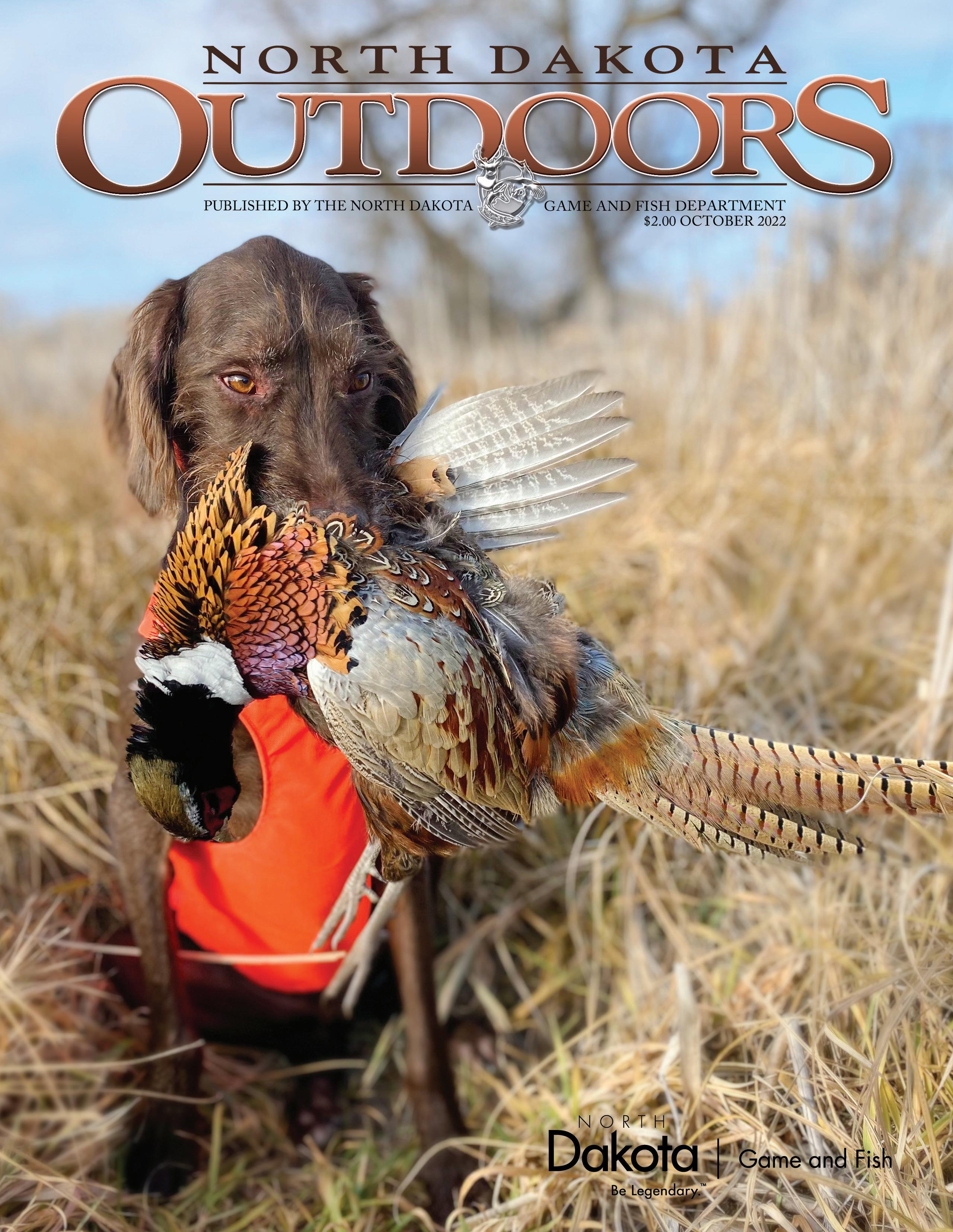
ADMINISTRATIVE DIVISION
Game and Fish Director: Jeb Williams
Deputy Director: Scott Peterson
Chief, Administrative Services: Kim Kary
Federal Aid Manager: Corey Wentland
Administrative Staff Officer: Justin Mattson
Administrative Assistant: Lynn Timm
Building Maint. Supervisor: Brandon Diehl
Administrative Officer: Melissa Long, Alan Peterson
Accounting Manager: Angie Morrison
Accountants: Kelly Wike, Ashley Hillerson
Business Operations Manager: Brian Hosek
Technical Operations Lead: Alan Reile
Data Scientist: Shane Wegner
Licensing Manager: Randy Meissner
Assistants: Gail Mosset, Amanda Anstrom, Tracy Price, Tana Bentz, Tanya Mikkelsen
Administrative Assistant – Dickinson: Stephanie Richardson
Administrative Assistant – Devils Lake: Lisa Tofte
Administrative Assistant – Jamestown: Tonya Kukowski
Administrative Assistant – Riverdale: Mattea Bierman
Administrative Assistant – Williston: Nikki Wright
CONSERVATION AND COMMUNICATIONS DIVISION
Division Chief: Greg Link, Bismarck
Communications Supervisor: Greg Freeman, Bismarck
Editor: North Dakota OUTDOORS: Ron Wilson, Bismarck
R3 Coordinator: Cayla Bendel, Bismarck
Digital Media Editor: Lara Anderson, Bismarck
Video Project Supervisor: Mike Anderson, Bismarck
Photographer/Videographer: Ashley Peterson, Bismarck
Marketing Specialist: Jackie Ressler, Bismarck
Information Specialist: Dawn Jochim, Bismarck
Graphic Artist: Kristi Fast, Bismarck
Education Supervisor: Marty Egeland, Bismarck
Education Coordinator: Jeff Long, Bismarck
Hunter Education Coordinator: Brian Schaffer, Bismarck
Outreach Biologists: Doug Leier, West Fargo; Greg Gullickson, Minot; Jim Job, Grand Forks
Conservation Supervisor: Steve Dyke, Bismarck
Resource Biologists: John Schumacher, Bruce Kreft, Bismarck
Conservation Biologists: Sandra Johnson, Patrick Isakson, Elisha Mueller, Bismarck
Administrative Assistant: Amber Schroeter, Bismarck
ENFORCEMENT DIVISION
Division Chief: Scott Winkelman, Bismarck
Investigative Supervisor: Jim Burud, Kenmare Operations Supervisor: Jackie Lundstrom, Bismarck
Warden Pilot: Jeff Sieger, Bismarck
Region No. 1 Warden Supvr: Mark Pollert, Jamestown
District Wardens: Corey Erck, Bismarck; Michael Sedlacek, Fargo; Andrew Dahlgren, Milnor; Erik Schmidt, Linton; Greg Hastings, Jamestown
Region No. 2 Warden Supvr: Paul Freeman, Devils Lake
District Wardens: Jonathan Tofteland, Bottineau; Jonathan Peterson, Devils Lake; James Myhre, New Rockford; Blake Riewer, Grand Forks; Alan Howard, Cando; Peter Miley, Cavalier; Drew Johnson, Finley; Sam Feldmann, Rugby Region No. 3 Warden Supvr: Doug Olson, Riverdale
District Wardens: Joe Lucas, Turtle Lake; Ken Skuza, Riverdale; Michael Raasakka, Stanley; Connor Folkers, Watford City; Shawn Sperling, Minot; Keenan Snyder, Williston, Josh Hedstrom: Tioga Region No. 4 Warden Supvr: Dan Hoenke, Dickinson District Wardens: Kylor Johnston, Hazen; Art Cox, Bowman; Courtney Sprenger, Elgin; Zane Manhart, Golva; Jerad Bluem, Mandan; Zachary Schuchard, Richardton Administrative Assistant: Lori Kensington, Bismarck
WILDLIFE DIVISION
Division Chief: Casey Anderson, Bismarck
Assistant Division Chief: Bill Haase, Bismarck
Game Mgt. Section Leader: Stephanie Tucker, Bismarck
Pilot: Jeff Faught, Bismarck
Upland Game Mgt. Supvr: Jesse Kolar, Dickinson Upland Game Mgt. Biologist: Rodney Gross, Bismarck
Migratory Game Bird Mgt. Supvr: Mike Szymanski, Bismarck
Migratory Game Bird Biologist: Andrew Dinges, Bismarck
Big Game Mgt. Supvr: Bruce Stillings, Dickinson Big Game Mgt. Biologists: Bill Jensen, Bismarck; Brett Wiedmann, Dickinson; Jason Smith, Jamestown
Survey Coordinator: Chad Parent, Bismarck
Wildlife Veterinarian: Dr. Charlie Bahnson, Bismarck
Wildlife Health Biologist: Brent Weston, Bismarck Game Management Technician: Ryan Herigstad, Bismarck
Wildlife Resource Management Section Leader: Kent Luttschwager, Williston Wildlife Resource Mgt. Supvrs: Brian Prince, Devils Lake; Brian Kietzman, Jamestown; Dan Halstead, Riverdale; Blake Schaan, Lonetree; Levi Jacobson, Bismarck
Wildlife Resource Mgt. Biologists: Randy Littlefield, Lonetree; Rodd Compson, James town; Judd Jasmer, Dickinson; Todd Buckley, Williston; Jake Oster, Riverdale
Wildlife Techs: Tom Crutchfield, Jim Houston, Bismarck; Dan Morman, Robert Miller, Riverdale; Jason Rowell, Jamestown; Micah Ranum, Brandon Ramsey, Lonetree; Scott Olson, Devils Lake; Zach Eustice, Williston
Private Land Section Leader: Kevin Kading, Bismarck
Private Land Field Operation Supvrs: Nathan Harling, West Region; Curtis Francis, East Region, Bismarck
Private Land Biologists: Colin Penner, Bismarck; Jaden Honeyman, Ryan Oberhelman, Dickinson; Ryan Huber, Riverdale; Renae Schultz, Jamestown; Terry Oswald, Jr., Lonetree; Andrew Ahrens, Devils Lake; Jens Johnson, Bismarck; Erica Sevigny, Williston
Procurement Officer: Dale Repnow, Bismarck
Administrative Assistant: Alegra Powers, Bismarck
Lonetree Administrative Assistant: Diana Raugust, Harvey
FISHERIES DIVISION
Division Chief: Greg Power, Bismarck
Fisheries Mgt. Section Leader: Scott Gangl, Bismarck
Fisheries Supvrs: Jason Lee, Riverdale; Paul Bailey, Bismarck; Randy Hiltner, Devils Lake; Dave Fryda, Riverdale; Brandon Kratz, Jamestown
Fisheries Biologists: Russ Kinzler, Riverdale; Todd Caspers, Devils Lake; Aaron Slominski, Williston; Mike Johnson, Jamestown; Jeff Merchant, Dickinson
Fisheries Techs: Phil Miller, Devils Lake; Pat John, Jamestown; Justen Barstad, Bismarck; Brian Frohlich, Riverdale
Production/Development Section Supvr: Jerry Weigel, Bismarck
Aquatic Nuisance
Typically, most of the Hungarian partridge harvest is incidental while hunters pursue grouse or pheasants, but this year, with partridge numbers looking impressive, there may be pockets where hunters could focus primarily on partridge.
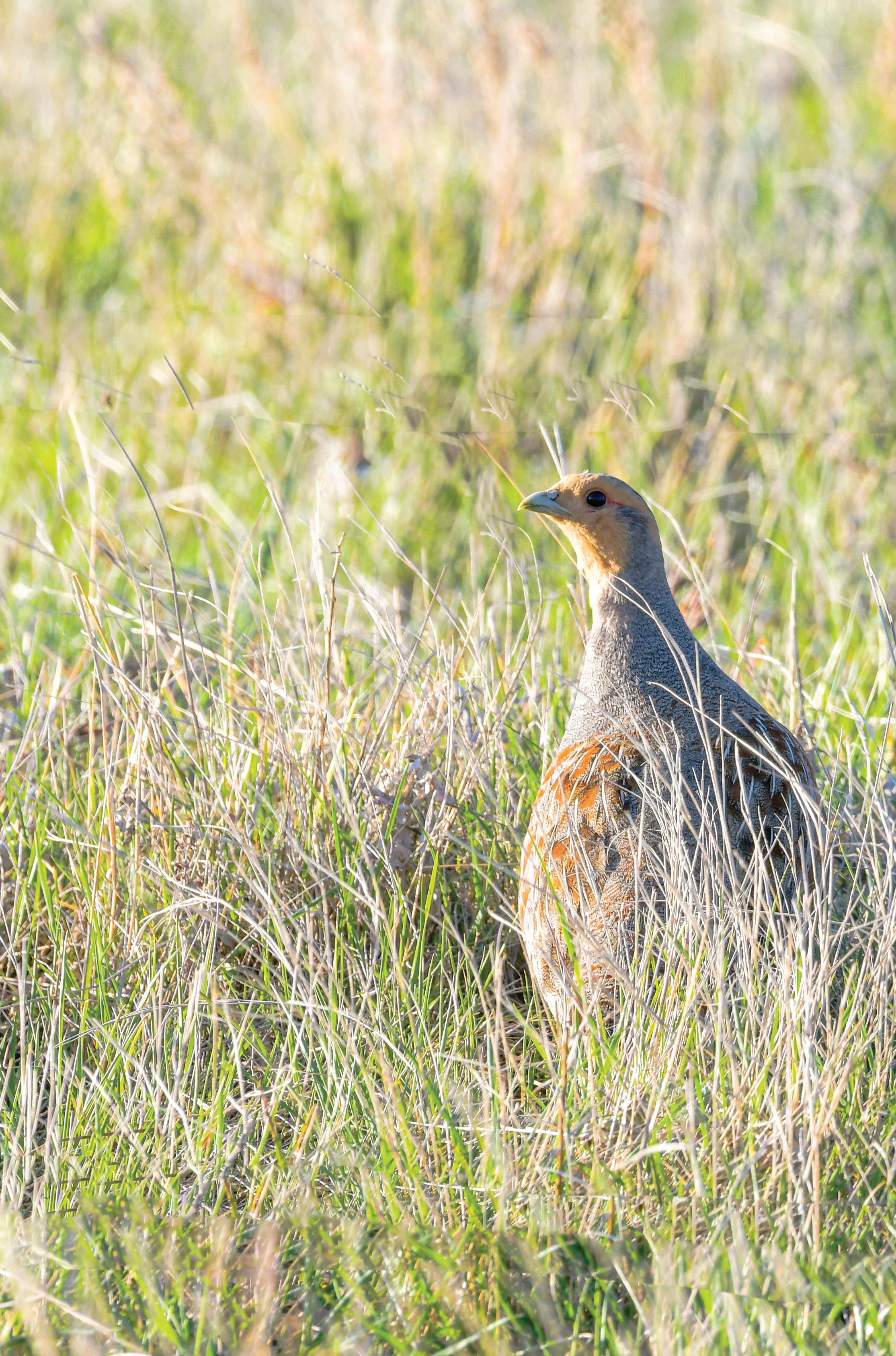
Official publication of the North Dakota Game and Fish Department (ISSN 0029-2761)
N. Bismarck Expressway, Bismarck, ND 58501-5095
gf.nd.gov
Information
Administration
Email: ndgf@nd.gov
Licensing 701-328-6335
North Dakota Outdoors
Hunter
The TTY/TTD
is
Report All Poachers
ND) number for the hearing or speech
cooperation with North Dakota
Periodical Postage Paid at Bismarck, ND 58501 and additional entry offices. Printed in the United States
POSTMASTER: Send address changes to:
North Dakota OUTDOORS 100 North Bismarck Expressway Bismarck, ND 58501-5095
Federation and North Dakota State Radio.
DEPARTMENT DIRECTORY Governor Doug Burgum
Species Coordinator: Benjamin Holen, Jamestown Aquatic Nuisance Species Biologist: Grant Kapaun, Bismarck Aquatic Habitat Supvr: Scott Elstad, Bismarck Fisheries Development Supvr: Bob Frohlich, Bismarck Fisheries Dev. Proj. Mgr: Wesley Erdle, Bismarck Fisheries Development Specialist: Kyle Hoge, Mason Ryckman, Zach Kjos, Bismarck Administrative Assistant: Janice Vetter, Bismarck ADVISORY BOARD District 1 Beau Wisness, Keene District 2 Travis Leier, Velva District 3 Edward Dosch, Devils Lake District 4 Bruce Ellertson, Michigan District 5 Doug Madsen, Harwood District 6 Cody Sand, Ashley District 7 Jody Sommer, Mandan District 8 Rob Brooks, Rhame
(RAP) 701-328-9921 In
Wildlife
100
Website:
•
•
701-328-6300 •
•
701-328-6305 •
Subscriptions 701-328-6363 •
Education 701-328-6615 •
(Relay
impaired
800-366-6888
Dakota
North Dakota OUTDOORS is published 10 times a year, monthly except for the months of April and Septem ber. Subscription rates are $10 for one year or $20 for three years. Group rates of $7 a year are available to organizations presenting 25 or more subscriptions. Remittance should be by check or money order payable to the North Dakota Game and Fish Department. Indicate if subscription is new or renewal. The numbers on the upper right corner of the mailing label indicate the date of the last issue a subscriber will receive unless the subscription is renewed.

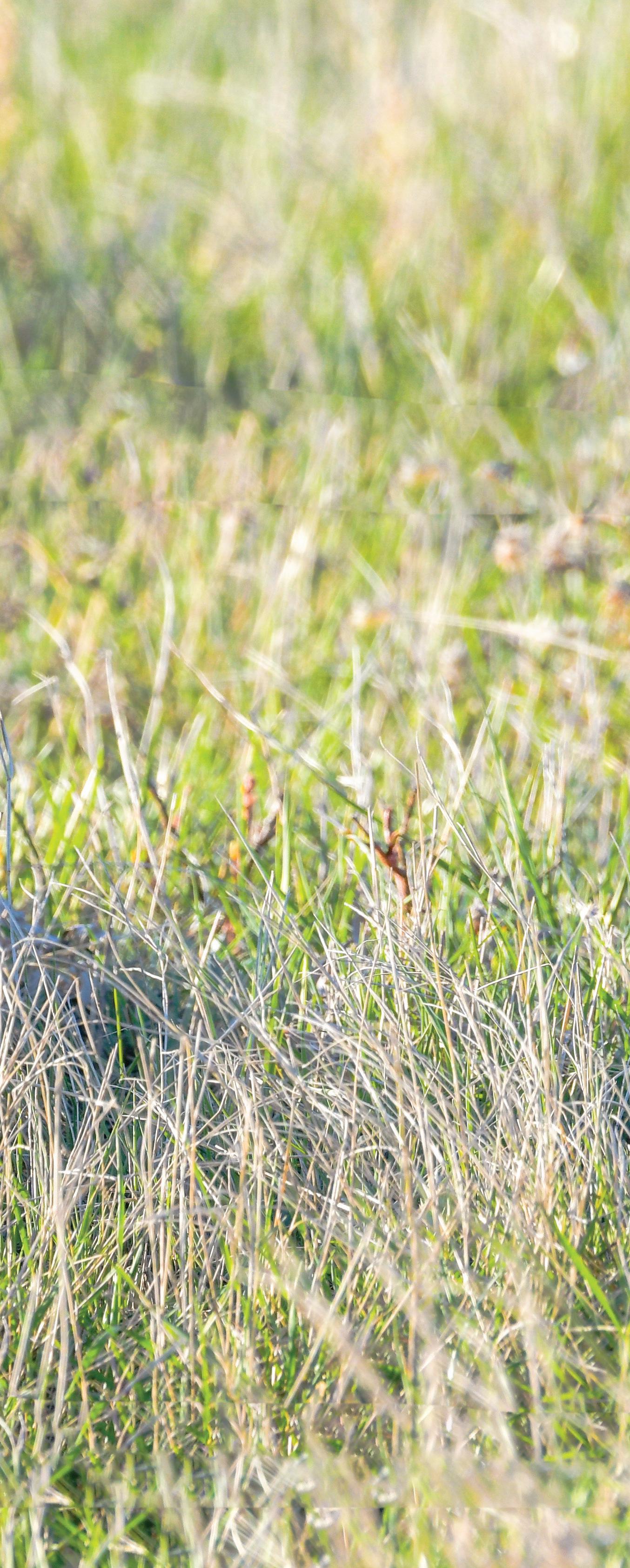

Permission to reprint materials appearing in North Dakota OUTDOORS must be obtained from the author, artist or photographer. We encourage contributions; contact the editor for writer and photography guidelines prior to submission.
The NDGFD receives Federal financial assistance from the US Fish and Wildlife Service and the US Coast Guard. In accordance with Title VI of the Civil Rights Act of 1964, Section 504 of the Rehabilitation Act of 1973, Title II of the Americans with Disabilities Act of 1990, the Age Discrimination Act of 1975, and Title IX of the Education Amendments of 1972, the NDGFD joins the US Department of the Interior and its Bureaus and the US Department of Homeland Security in prohibiting discrimination on the basis of race, color, national origin, age, disability, sex (in education programs or activities) and also religion. If you believe you have been discriminated against in any program, activity, or facility as described above, or you desire further informa tion, please write to: ND Game and Fish Department, Attn: Chief of Administrative Services, 100 N. Bismarck Expressway, Bismarck, ND 58501-5095 or to: Office of Civil Rights, Department of the Interior, 1849 C Street, NW, Washington, DC 20240.
The mission of the North
Game and Fish Department is to protect, conserve and enhance fish and wildlife populations and their habitats for sustained public consumptive and nonconsumptive use. OCTOBER 2022 • NUMBER 3 • VOLUME LXXXV ■ Editor: Ron Wilson ■ Graphic Designer: Kristi Fast ■ Circulation Manager: Dawn Jochim CONTENTS Front Cover October in North Dakota means the season opens for North Dakota’s most popular upland game bird, the ringnecked pheasant. Photo by Scott Clausen Bismarck. 2 North Dakota Landscape Staple 6 Big Walleye Bite 10 Closer Look at the Blue Squares 14 Hidden in Plain Sight 20 Buffaloberry Patch 25 Back Cast SANDRA JOHNSON
LANDSCAPE STAPLE
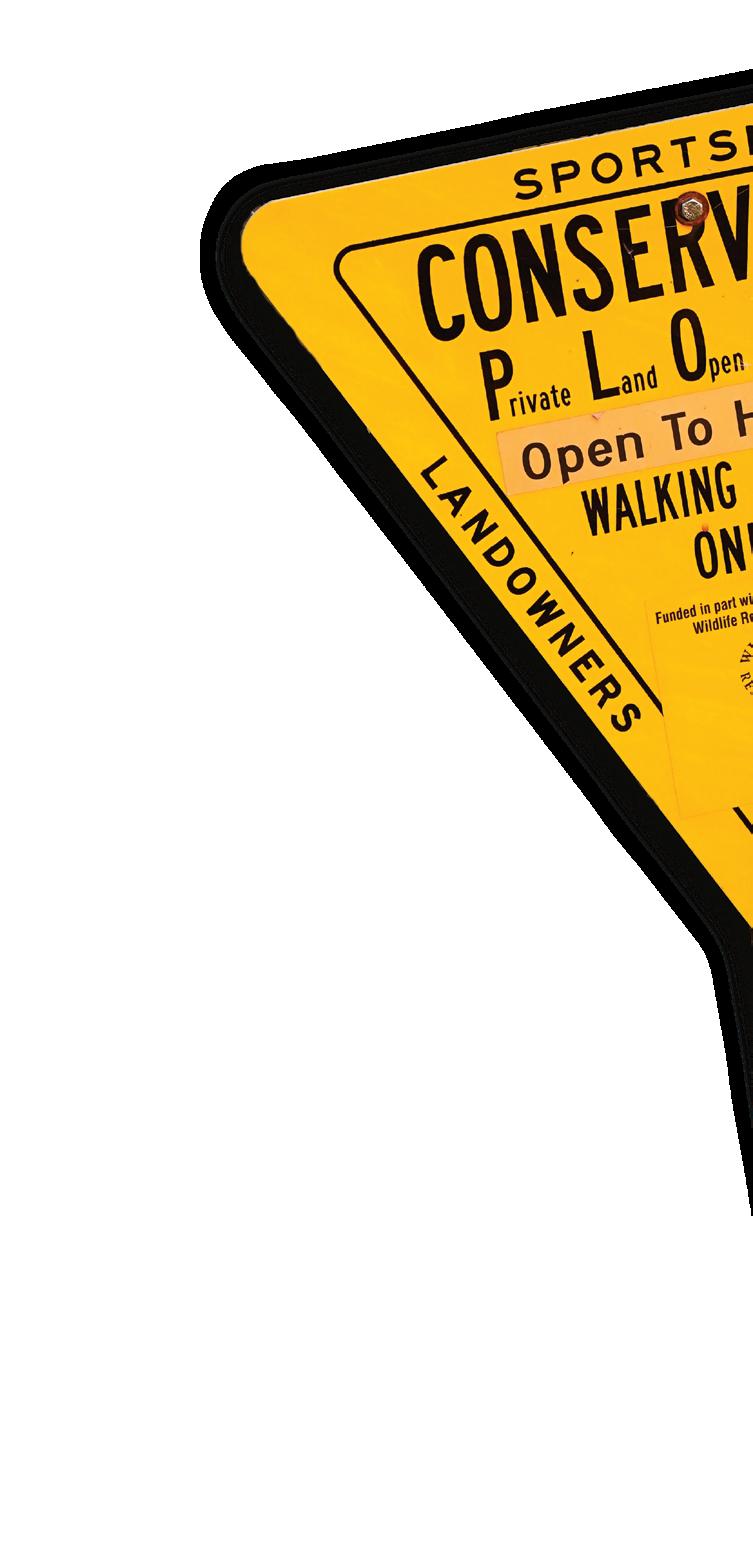
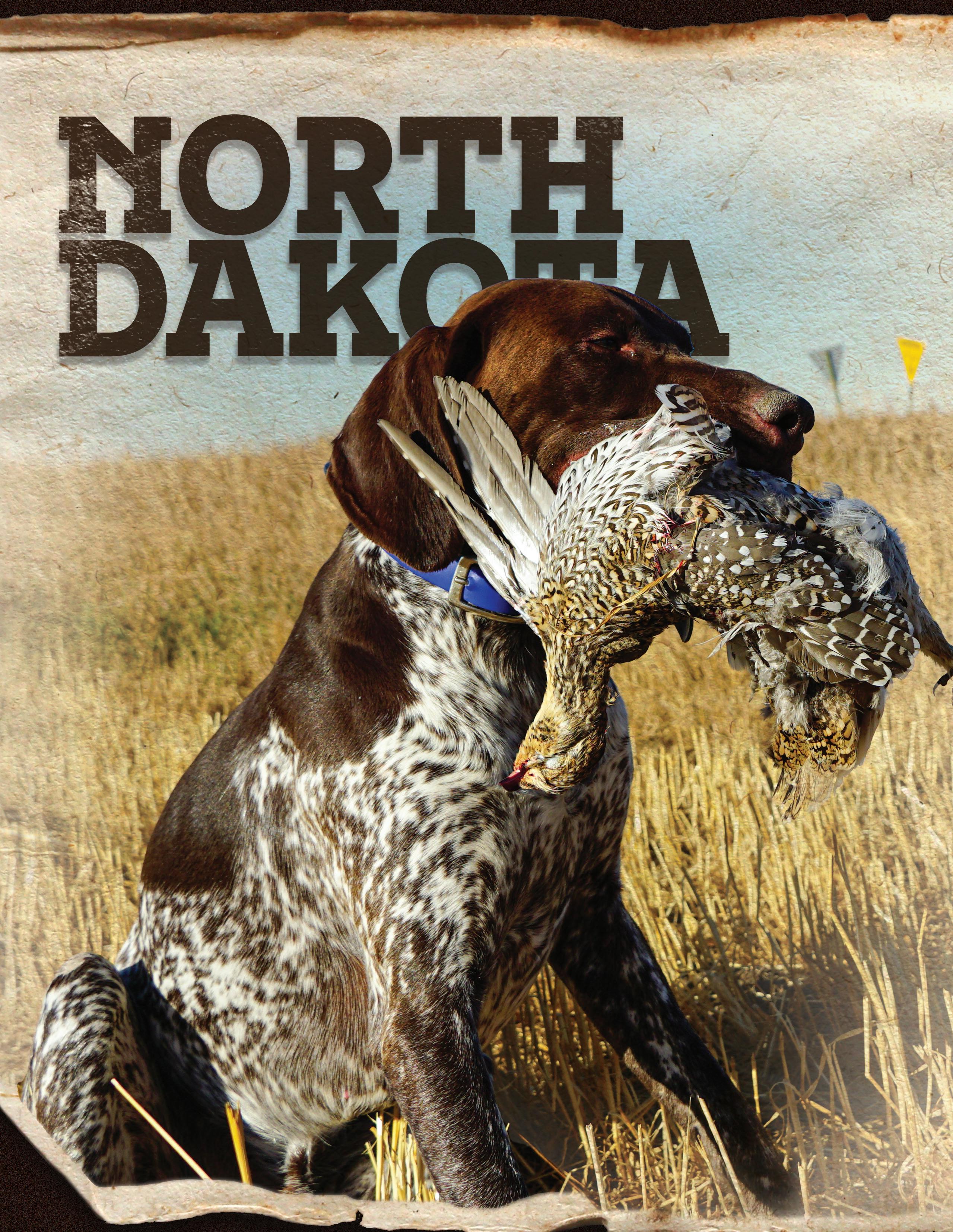 SANDRA JOHNSON
SANDRA JOHNSON
2 ■ ND OUTDOORS ■ OCTOBER 2022
North Dakota Game and Fish Department Private Land Open To Sportsmen signs were first added to the landscape in the late 1990s in six counties –Adams, Dickey, Divide, Grant, Hettinger and Morton – primarily because of their importance to pheasant hunting. Today, these familiar yellow signs are found state wide.
Kevin Kading, Department private land section leader, addresses the status of the walk-in access program that is easily recognizable and popular with more than a gen eration of hunters.
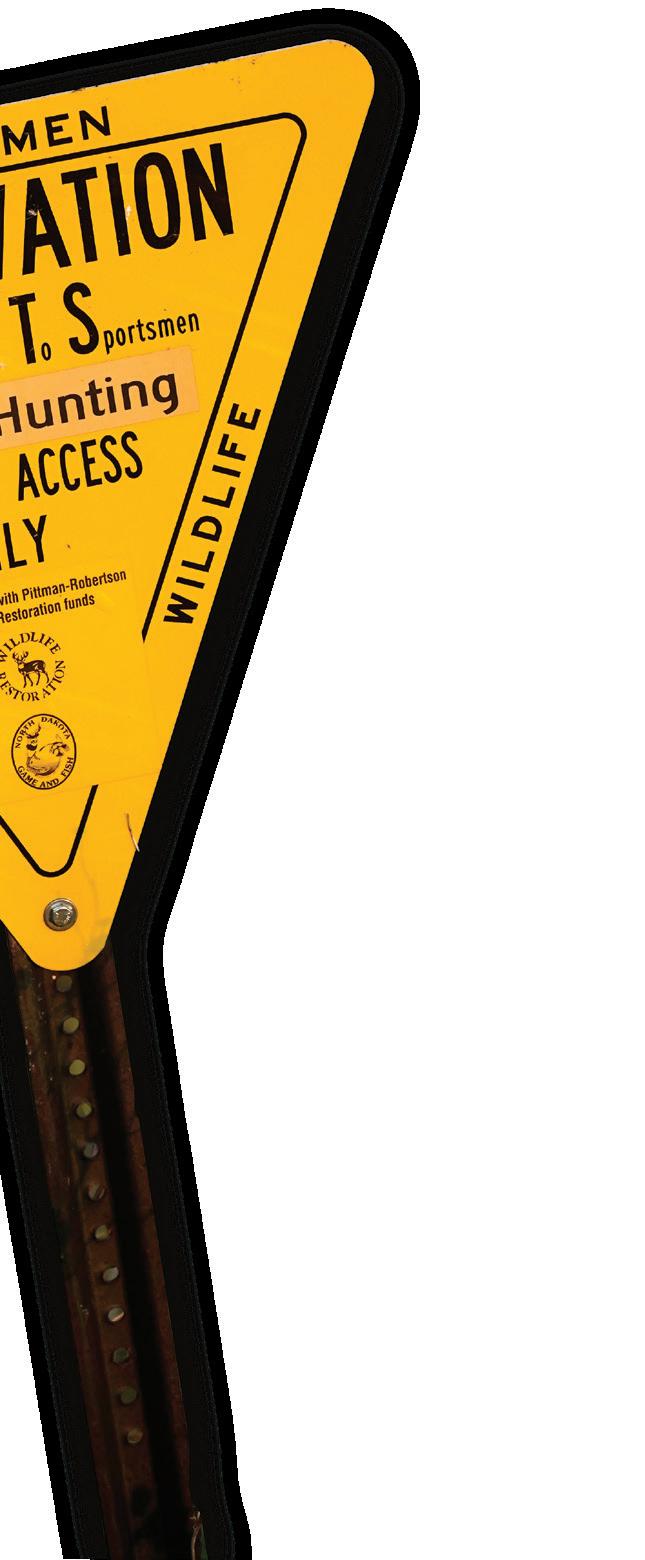
NDO: The 2022 PLOTS Guide was made available to the public in August. How many PLOTS acres are featured in the guide this year?
Kading: Overall, the PLOTS Program is sitting about the same as 2021 at about 800,000 acres. If we split the program into two regions, the western region of the state did see a little bit of a decrease in acres, while the eastern region saw a little bit of an increase in acres.
NDO: PLOTS acres expire throughout the year. Explain that?
Kading: That’s part of the nature of private land programs. These are private lands enrolled in an agreement with the Game and Fish, so some agreements with landowners are as short as two years and some of them are lon ger than that, maybe up to 20 years. And every year we’re always chasing those agreements that are expiring and working with landowners to give them an option to renew. Some do, most do, but some don’t. And then we also have new acres coming into the program. In a way, that’s kind of a nice thing to kind of move things around a little bit. Hunters get new options and new opportunities to hunt different areas that they haven’t hunted. But you also have some that have been on the land scape or in the program for a long time and hunters like to go back to some of those areas, too.
NDO: A year ago North Dakota was in the middle of a drought. How are things looking this year?
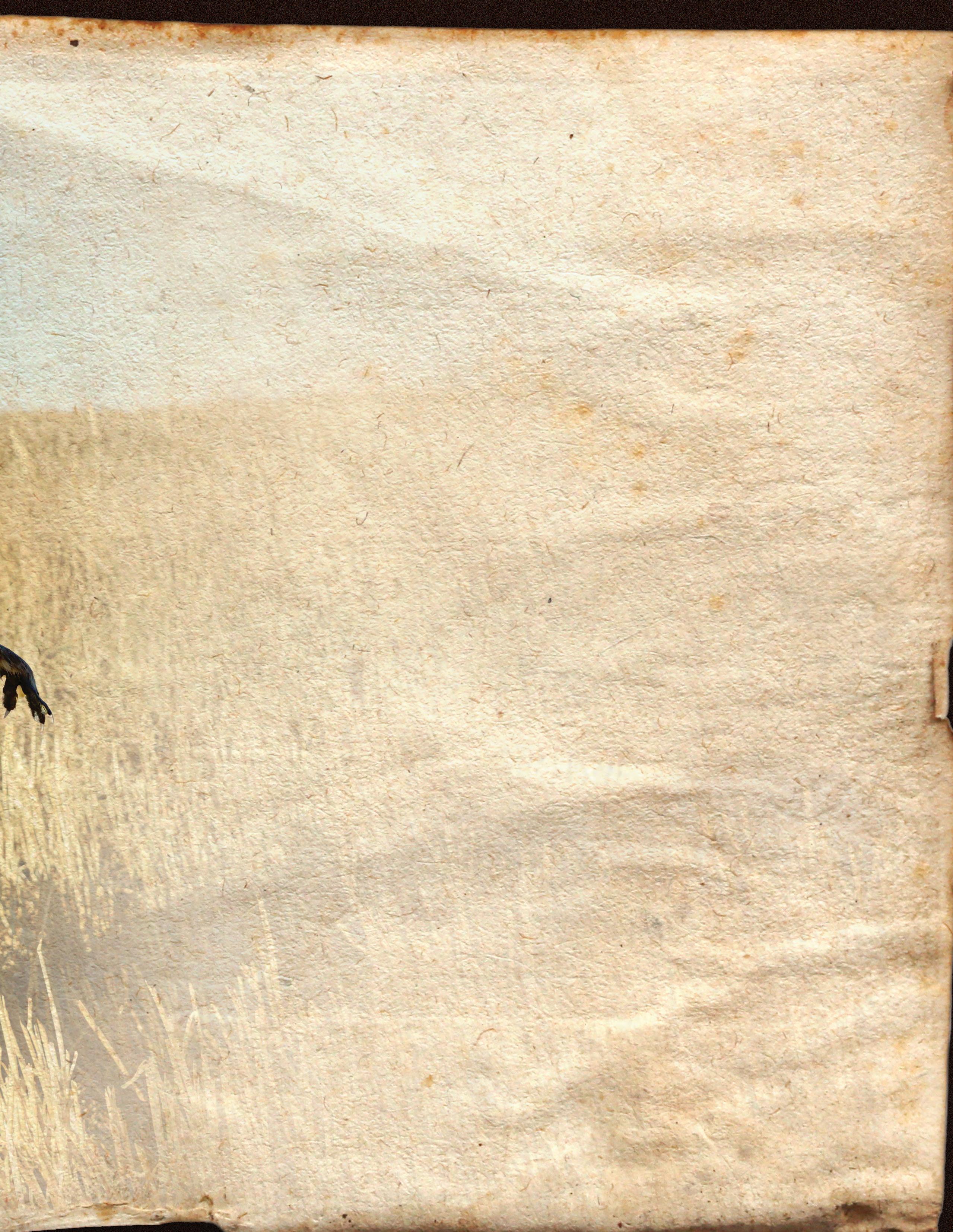
It’s just been unbelievable, with the rebound and the recovery of the grasslands across the state. From a wildlife standpoint, it’s going to help a lot. And from hunting cover, habitat wise, the PLOTS tracts are looking a lot better this year. Just in general, everywhere across the state looks a lot
better. Certainly, hunters will find some better cover this year on PLOTS tracts.
NDO: Let’s talk about haying on PLOTS acres. Last year a lot of PLOTS acres were hayed in response to the dry conditions and the dire need for feed for cattle. Does that happen every year?
Kading: There a lot of different things going on with PLOTS agreements. Some of the agreements are tied in with the USDA program, for example, like CRP. And so, they must follow provisions of their CRP contract. We do restrict some haying so there’s habitat left out there at the end of the year, we don’t want to see it all hayed, but we also understand it’s an opportunity for producers to get some forage off those acres. We get some management out there that you might not otherwise get, and those grasses need something. Nearly all PLOTS agreements have some ability for haying or grazing. We typically wait until after Aug. 2 for haying to take place. That just helps birds get off the nests, get the broods out moving around so they can escape the sickle mower and the hay binder.
NDO: Let’s say a hunter pulls up to a PLOTS tract and they find some nice habitat, but the rest of the field is crop. Why is that?
Kading: Not every PLOTS agreement is the same and not every PLOTS acre is the same. Some of our PLOTS agreements you might see some more cropland. Some might have more pastureland, and some might have some hay land. The bottom line is that Game and Fish biologists wouldn’t sign those acres up if there wasn’t some hunting value out there somewhere. And that could be, for example, waterfowl hunting access in a stubble field. It could be a wetland on the back corner. It could be that
ND OUTDOORS ■ OCTOBER 2022 ■ 3
there’s management being performed out there. So, maybe the year that you show up out there, it might be a stubble field, but if you come back in two years it might be a newly planted grassland that’s being developed for wildlife habitat.
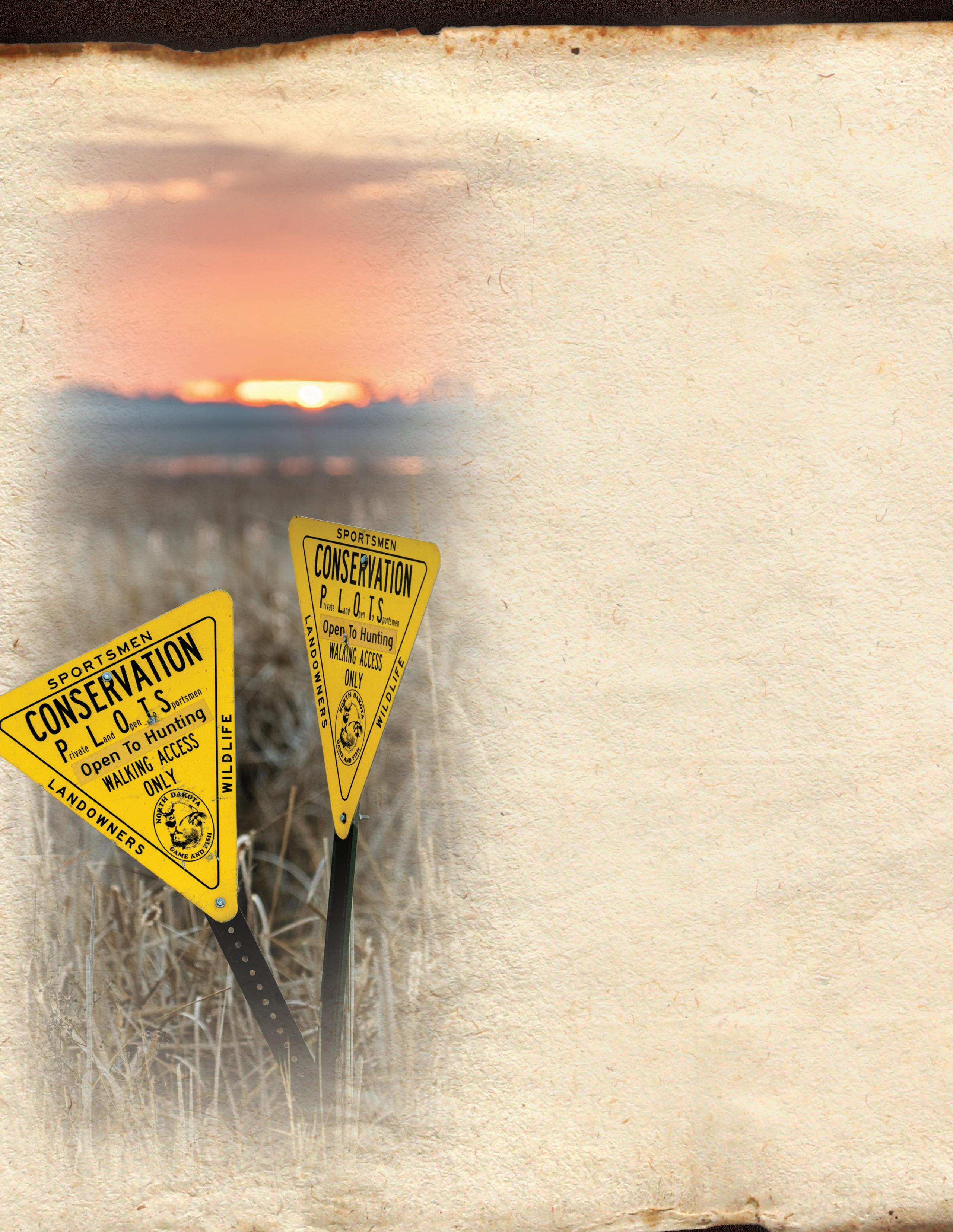
NDO: Let’s talk about the PLOTS Guide. Obviously, hunters can get their hands on a physical PLOTS Guide, but they can access the guide electronically as well.
Kading: Like everything else in today’s world, a lot of stuff is going electronic, and PLOTS is no different. The PLOTS Guide is still produced and published in the printed form, but every year that seems to go down a little bit or is in less demand. More hunters are using smartphones and different apps on their phones or accessing it on our website. Either way, people that still want to get a printed guide can still get their hands on that as well.
NDO: Address some of the rules and regulations and hunting ethics on PLOTS acres.
Kading: First and foremost, the PLOTS tracts are for walk-in hunting access. Anything other than walk-in access for hunt ing requires landowner permission. One of those things that require landowner permission is if you wanted to go out there and do some shed hunting. Other things to be aware of when you’re out on a PLOTS tract hunting, we don’t necessarily have designated parking areas because they’re private land. There’s usually a field approach or a place that you can get off the road, so hunters need to make sure you do that to avoid accidents, stay out of the way of equipment, farm machinery, that type of thing. But also, don’t block a gate, try to move off to the side if you can. And when it comes to gates, make sure they’re left the way you found them. Sometimes they’re open for a reason, maybe the landowner is hauling grain or hauling hay in and out of there. But if they’re open, leave them. If they’re closed, close them. Most of the time, you don’t need to be driving in on those areas anyway. A lot of times you shouldn’t be. For the most part, we just want hunters to remember these are private lands and treat them with respect, treat them like it was your land. Typically, most hunters are doing the right thing. We don’t have a lot of problems, but we’ve had landowners not renew their PLOTS agreements just because of poor hunter behavior. Keep that in mind and know that your actions make a difference out here. If hunters want more PLOTS acres and they want to continue to enjoy PLOTS acres, we all need to treat them with respect.
NDO: Hunters should pick up their spent shells, litter and whatever they introduce to the landscape.
Kading: We just want people to just do the right thing out
ASHLEY PETERSON 4 ■ ND OUTDOORS ■ OCTOBER 2022
there. If you see someone else’s garbage, pick it up if you can. Remember the little things like shells. In a field-hunting situation for waterfowl, hunters can get into situations where they are shooting a lot and a lot of shells end up in the field, and it really doesn’t take a whole lot to pick those up. But I’ve heard producers over the years say they don’t like coming across that, they’re going out there farming and they see a pile of empty shell casings.
NDO: How about trapping, cable devices? You said PLOTS are just for hunting, but how about trapping?
Kading: Trapping in North Dakota does require written landowner permission. So, whether you’re on a PLOTS tract or just on private land, you need written permission. If you’re out there with a hunting dog, be aware there could be traps or snares. And if you’re a trapper or a snarer, make sure you’re aware of that too, and that might not be the best place for setting up snares if you have people and hunting dogs out there. PLOTS tracts are typically hunted for upland game and waterfowl, so there’s usually dogs involved and it’s just not a good combination if you can help it. But after the bird season, after upland game bird seasons, that’s when a lot of people start doing their snaring anyway.
NDO: We already mentioned a little bit about habitat, but let’s talk about habitat on PLOTS land.
Kading: We do have a lot of good habitat on PLOTS and we’re always working to manage more habitat. In the last 10 years it’s become more difficult to maintain habitat on PLOTS and to enroll good lands that have a lot of habitat. The reason for that is pretty simple when you look across the state at our shrinking habitat base. We talk a lot about CRP, and that’s one thing that’s very noticeable. We had 3.5 million acres of CRP, now we’re down to a little over 1.1 million acres. And not all of those acres are not in grass anymore. Some of those are still in grass. Maybe they’re still being hayed or grazed or something. But a lot of those have gone to ag pro duction. We’re not putting blame on the producer for doing that. A lot of times they even tried to get it back into CRP, but they weren’t accepted, or it didn’t meet the criteria. And so, the habitat base in North Dakota has shrunk quite a bit in the last 10 years, and that happens on PLOTS as well. Where before it was easy for us to enroll good quality lands because the habitat base was there, the Department is having to spend more time on developing habitat as well, which costs more money, takes more time. A lot more goes into planting a field with grass and developing that habitat than it did before. It’s just a little bit more of a challenge than it was just five, 10 years ago.
PLOTS ONLINE
The North Dakota Game and Fish Department’s Private Land Open To Sports men Guide for 2022 is available online on the Department’s website, gf.nd.gov. In addition, the free printed PLOTS guides are available at most license vendors and other locations throughout the state.
The guide features about 800,000 PLOTS acres. Because the guide is printed in midAugust, some PLOTS tracts may have been removed from the program since the time of printing. There will also be some PLOTS tracts where the habitat and condition of the tract will have changed significantly. Conversely, Game and Fish may have added new tracts to the program after the guide went to press.
To minimize possible confusion, Game and Fish will update PLOTS map sheets weekly on its website.
The PLOTS Guide features maps high lighting these walk-in areas, identified in the field by inverted triangular yellow signs, as well as other public lands.
The guides are not available to mail, so hunters will have to pick one up at a local vendor or Game and Fish offices or print individual maps from the website.
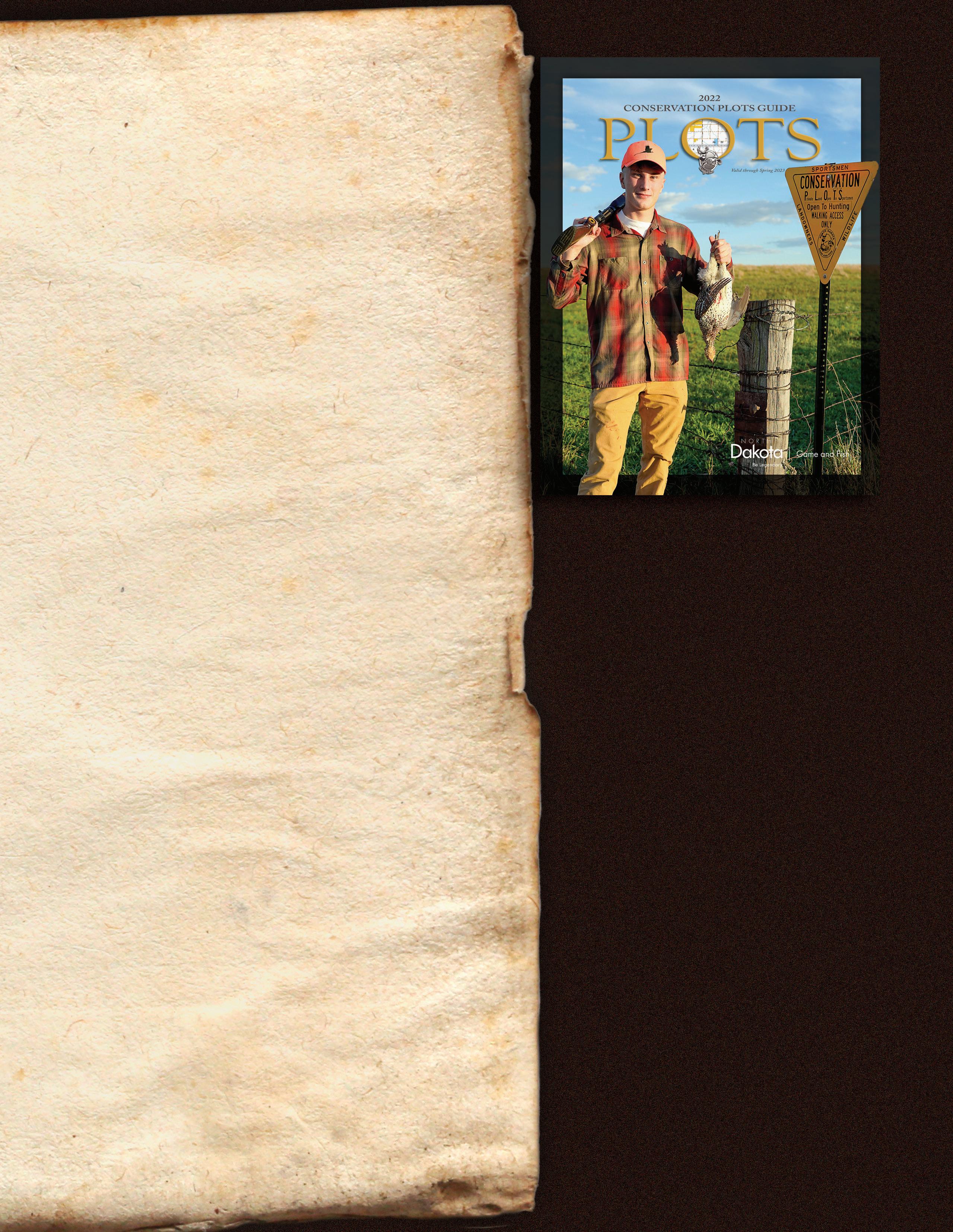
MIKE ANDERSON ND OUTDOORS ■ OCTOBER 2022 ■ 5
Angling for walleye is a year-round pur suit for many and we’re fortunate our state provides the opportunity to land a fish for a photo or the frying pan no matter the date on the calendar.
Die-hard anglers have likely noticed that the sizes of walleye they encounter change in a predictable pattern throughout the year whether they are fishing on the Missouri River System, Devils Lake, or one of our numerous prairie lakes. This pattern and the reasons for it have been the subject of many boat or beach conversations with plausible explanations ranging from “anglers harvested all the females in the spring,” “the big fish hide in the weeds during summer,” “egg-laden females bite better right before the spawn,” “the large fish migrate downstream every summer,” “the big girls strap on the feedbag in fall,” to “little fish bite better when the water is warmest.”
As one of North America’s premier sportfish, walleye have been extensively studied by fisheries scientists and a wealth of biological information exists for this species. The North Dakota Game and Fish Department has also conducted numerous tag ging studies that support or dispel the statements above.
So, what is fact and what is fiction?
PRAIRIE LAKE EXAMPLE
First, let’s take a look at the tagged walleye anglers reported catching in Alkaline Lake in Kidder County during the 2019-20 tagging study to see if there really are seasonal differences in the sizes of fish anglers are catching.
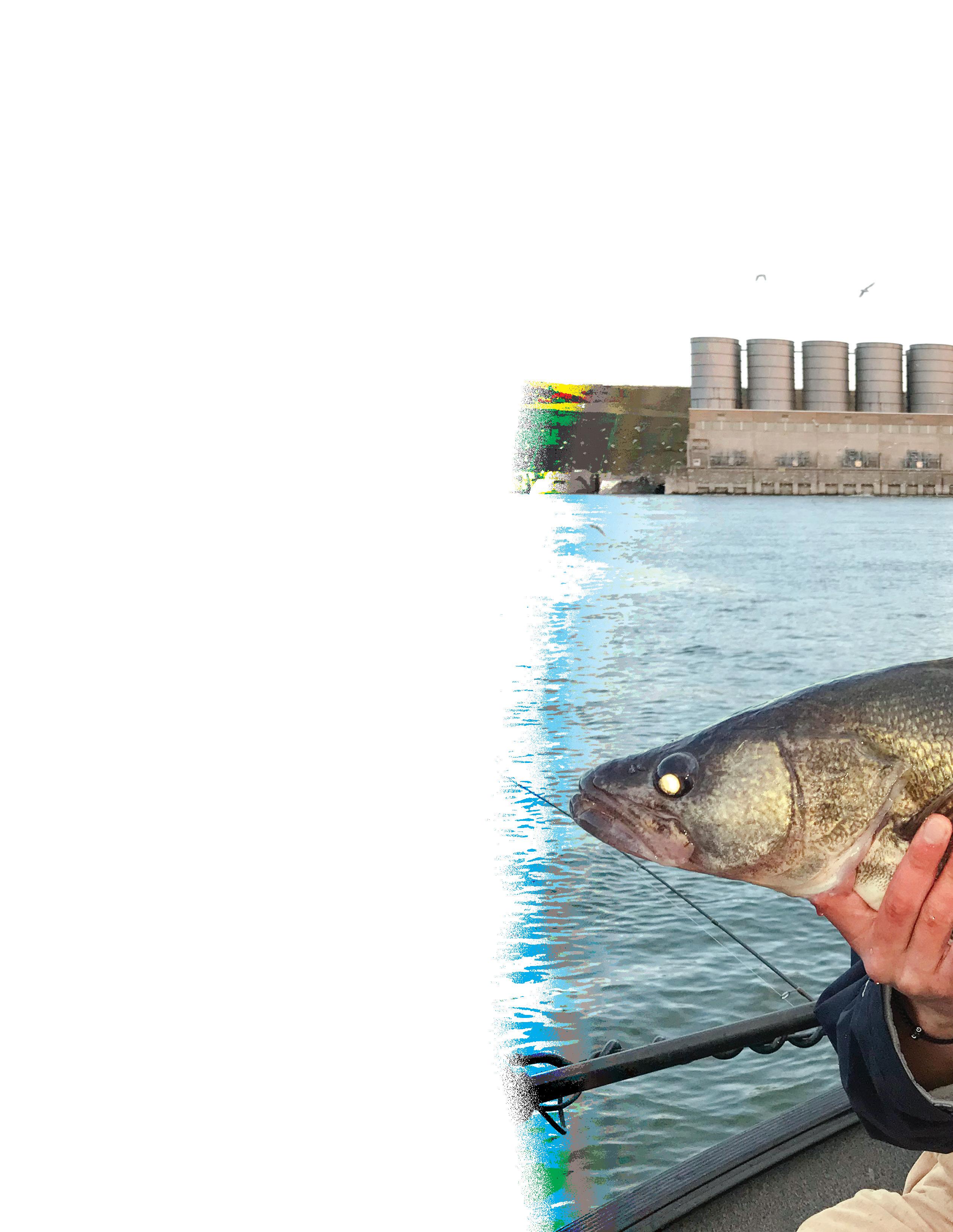
The Department tagged 1,995 walleye during this study, all of which were at least 13 inches long and the longest was 28.7 inches. These 1,995 tagged fish averaged 18.5 inches, but at certain times of the year, the average lengths of tagged walleye anglers reported catching were above or below 18.5 inches.
For example, the average size of tagged walleye reported by anglers was greatest during April-May (20.3 inches) followed by October-December (19.4 inches). Whereas the average length of tagged wall eye reported by anglers in July, August and Septem ber were much lower at 17.6 inches, 17.4 inches and 17.0 inches, respectively.
So, the Alkaline tagging study confirms the exis tence of a seasonal pattern in the sizes of walleye that anglers are likely to reel in. But why does this
pattern exist?

The seasonal differences anglers see in the sizes of walleye they catch are the result of two primary factors: water temperature and hormones.
Let’s start with temperature. Walleye are coldblooded animals whose body temperature is determined by the temperature of the water around them. As such, water temperature has an enor mous effect on virtually all aspects of a walleye’s life including their metabolic rate, how fast they grow, when they reproduce, how often they feed, and how fast they digest what they eat.
Interestingly, walleye of different ages and sizes have different preferred temperatures for feed ing and converting that food into growth in size or reproductive organs. And, you guessed it, walleye are more likely to eat an angler’s bait when temper atures are closer to optimal for that particular size of fish to feed. From the time they hatch through their first year of age, walleye prefer warmer tem peratures of around 72 degrees. Juvenile walleye (typically 8- to 15-inch fish) prefer intermediate water temperatures of approximately 64-72 degrees, and adult fish exhibit the greatest feeding and food conversion efficiency when water temperatures are in the low to mid-60s.
This relationship between walleye size and pre ferred feeding temperature partially explains the seasonal pattern in the sizes of walleye anglers catch in Alkaline Lake and many other lakes. Anglers are more likely to encounter larger wall eye during spring and fall when water tem peratures are closer to optimal for large (adult) walleye to feed. Smaller fish, on the other hand, are more likely to feed and cooperate with anglers when water temperatures are at their warmest in July through September.
Hormones also influence walleye feeding and how well fish cooperate with anglers. In the Percid family of fishes, of which walleye, sauger and yellow perch are prominent members, male and female hormones have the opposite effect on appetite.
6 ■ ND OUTDOORS ■ OCTOBER 2022
By Paul Bailey PAUL BAILEY

Cool water temperatures preferred by large walleye and elevated appetite-enhancing estrogen levels as egg production began combined to increase the likelihood of this large female walleye taking Carter Bailey’s bait on a late October morning.
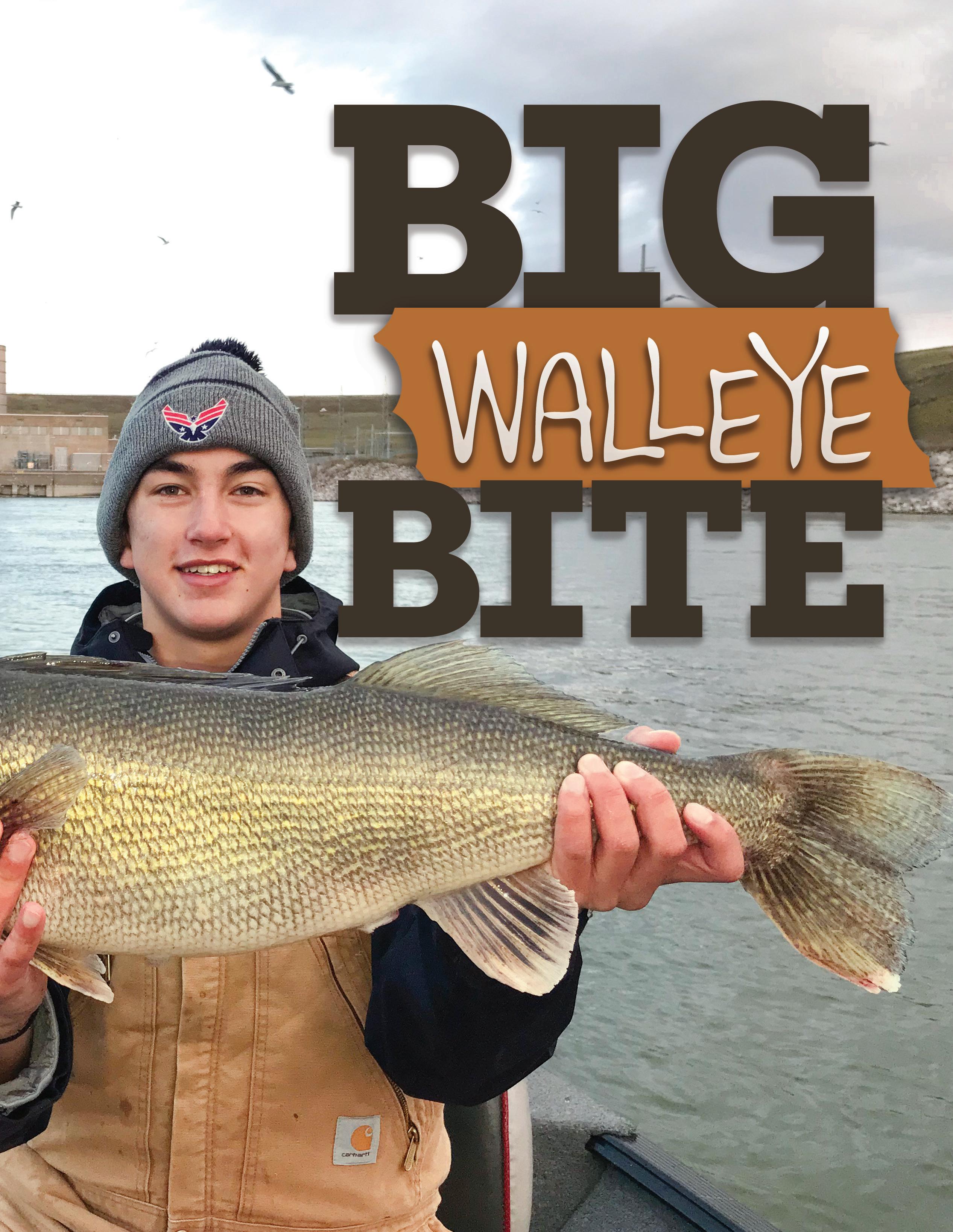
ND OUTDOORS ■ OCTOBER 2022 ■ 7
The walleye version of estrogen (the female reproductive hormone) enhances appetite when levels are increased. Estrogen levels are highest in female walleye as egg development begins in response to shortening day length (photoperiod) in late October and remain elevated through spawning.
The observation by many astute anglers that female wall eye “strap on the feedbag” in fall is an accurate one. Levels of appetite enhancing estrogen in female walleye drastically drop following the spring spawn and remain low until the cycle repeats itself the following fall. This annual estrogen cycle enhances the likelihood of female walleye cooperating with anglers from fall through spring.
Alternately, the walleye version of testosterone (the male reproductive hormone) acts as an appetite suppressant. Testosterone levels increase as gamete production begins in fall, remain elevated through the spring spawn, and then drop to low levels throughout summer. The lower levels of appetite suppressing testosterone in summer increases the likelihood of a male walleye biting your lure during this time.
Indeed, looking at data from the Alkaline Lake tagging study illustrates the impact of male and female hormones on when female walleye (which tend to be larger fish) and males (which tend to be smaller fish) are more likely to be caught by anglers. Sexually mature female walleye repre sented 30% of all walleye tagged at Alkaline Lake. However, sexually mature female walleye composed 44% of the fish anglers caught from fall through the spring spawn due
to the influence of elevated appetite enhancing estrogen. Female walleye only composed 27% of the fish anglers caught during summer due to the absence of both appetite enhancing estrogen in females and appetite suppressing testosterone in males.
The opposite effects of male and female reproductive hormones on appetite also helps to explain why a high pro portion of yellow perch caught by ice anglers are females with developing eggs.

Seasonal fluctuations in water temperature and hormone levels work together to influence the sizes of walleye more likely to cooperate with anglers at various times of the year. This certainly doesn’t mean an angler can’t land a whop per in August or that an 11-inch fish won’t be a nuisance in April, but it does mean that the probability of either of those things happening is reduced at those times of the year.
While water temperature and hormones are important factors, forage availability may also impact the number and sizes of fish anglers are catching in different habitats. For example, I was fishing the Logan Wildlife Management Area in Logan County late in the summer a decade or so ago and leopard frogs were littering the shoreline. Walleye large enough to swallow these frogs were feeding in 3-5 feet of water in stands of shoreline vegetation where frogs were most abundant. This led to outstanding fishing while pitching swimbaits in the shallows for some of the largest fish that the lake had to offer. Fishing Logan WMA’s deeper areas at this time tended to produce smaller fish with bellies full of caddisflies. Similar size segregations may occur dur ing spawning as mature walleye concentrate within shallow spawning habitats while immature fish generally remain in deeper areas.
THE MISSOURI RIVER SYSTEM
Water temperature and hormones also influence the sizes of walleye anglers catch on the Missouri River System. For example, as ice leaves the Missouri River and Lake Oahe fish ery each spring the warmest water is typically found in Lake Oahe’s headwaters near the Hazelton and Fort Rice areas. This is due to the deep, cold-water releases from Garrison Dam warming as they flow downstream, coupled with Lake Oahe taking longer to warm as its depth increases in down stream reaches.
It is no coincidence that Lake Oahe’s headwaters offer some of the best springtime walleye fishing in the region. While April water temperatures may be cool, they are closer to optimal for larger adult fish to feed than small fish, and females still have an enhanced appetite due to elevated estrogen levels that can lead to great fishing for larger fish.
As water temperatures warm towards optimal levels in both an upstream direction towards Garrison Dam and
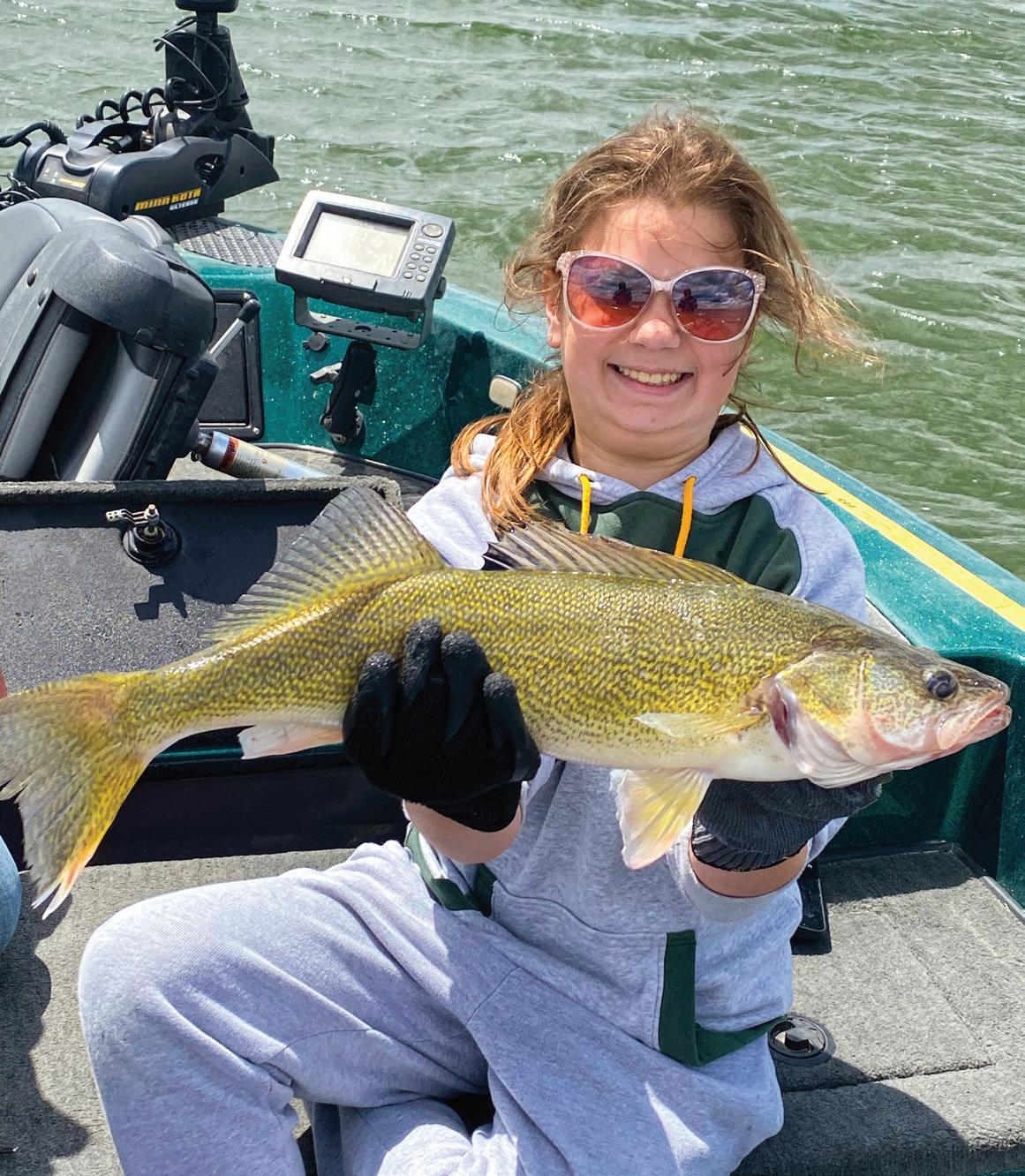
COREY ERCK
Sydney Erck with a nice North Dakota walleye.
8 ■ ND OUTDOORS ■ OCTOBER 2022
downstream towards Oahe Dam, the best fishing tends to progress in those directions as well. This leads to the best fishing (and anglers following that fishing) to move both upstream and downstream from the Hazelton and Fort Rice areas as spring progresses. Small fish tend to dominate angler catches during summer due to above optimal tem peratures for large walleye feeding and hormonal influences. Then, as fall returns, large fish are more likely to appear on the end of your line as temperatures decline and female fish regain their appetite.
So, how do we know if walleye are moving in an upstream or downstream direction in the Missouri River and Lake Oahe fishery along with these water temperatures or if are they staying put? Past tagging studies provide the answer.
During the 2013 through 2016 Missouri River and Lake Oahe walleye tagging study, fisheries personnel with the North Dakota Game and Fish Department, South Dakota Game, Fish and Parks, and South Dakota State University tagged over 34,000 walleye between Garrison and Oahe dams. Anglers have since reported catching nearly 9,000 of these fish, which allows us to draw some conclusions regard ing walleye movements throughout this system.
A small portion of the walleye tagged between Garrison and Oahe dams did move some impressive distances, up to nearly 300 miles from the Garrison Dam spillway channel to areas just upstream of Oahe Dam. However, those types of movements were far from typical. More often tagged fish that anglers reported to us moved very little from the loca tion where they were tagged. For example, approximately half of the fish anglers reported were caught within 10 miles of where they were tagged and 90% of fish were caught within 20 miles of where they were tagged.
That pattern holds true for the large female walleye that we tagged as well. Most of the female walleye that anglers reported catching were caught in relatively close proximity to the location where they were tagged. Addition ally, the Department conducts annual nighttime electrofishing surveys of the Missouri River near July 4 and an annual netting survey of Lake Oahe in mid-July and we routinely see large female walleye during these sampling events.
For example, we sampled a 28-inch walleye near the Fox Island boat ramp and a 29.5-inch walleye near Ft. Yates during our July 2022 sam pling. Our sampling tells us that large female walleye are still present throughout this fishery in July even though I, and many other anglers, are less likely to encounter one of these large fish on the end on our line during this time.
While walleye in the Missouri River System generally do not move very far, that does not
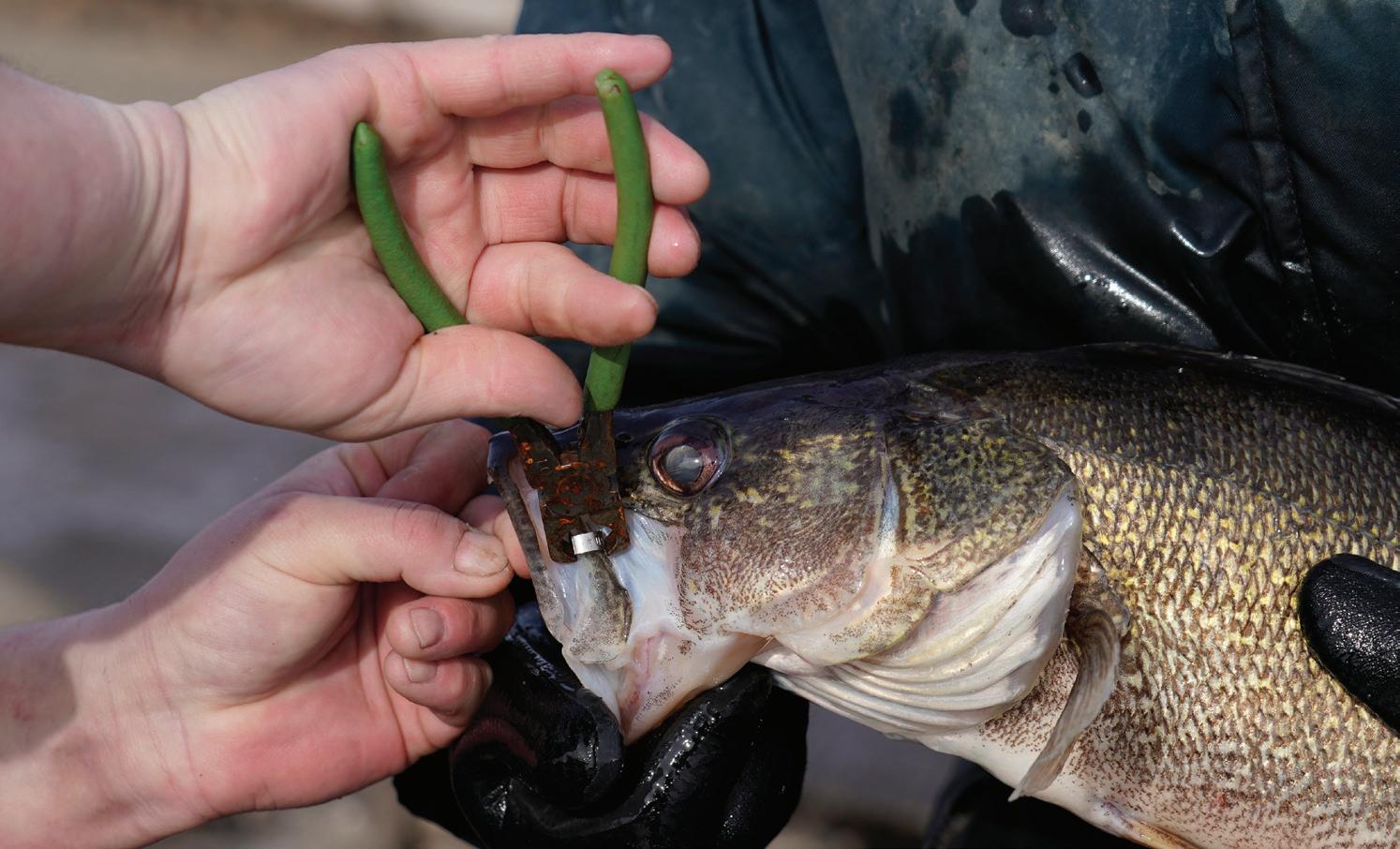

mean they don’t move at all. Walleye seek out different habi tat types to best meet their needs at different times of the year.
For example, a mature male walleye in the Missouri River south of Bismarck is likely to prefer overwintering in a deep, slow-moving pool where it can conserve energy as cold temperatures have slowed its metabolic rate and increased testosterone levels have reduced its appetite. When spring arrives, this fish is likely to seek out a spawning area, such as Huff Bluffs or Eckroth Bottoms, that has swifter current and areas of gravel/cobble.
Then, following the spawn and a reduction in appetite sup pressing testosterone levels, this male walleye is likely to seek out an area of intermediate depth and current velocity where foraging opportunities are most abundant. These different habitats are well distributed throughout the Missouri River System so walleye generally do not have to move very far to find the habitat they are looking for.
Recent tagging studies have shown that the vast major ity of walleye in the Missouri River System do not move far from the location where they were captured and tagged, but a small portion of walleye do wander greater distances. How ever, these longer movements appeared to be conducted randomly in either an upstream or downstream direction and certainly do not fit any description of a migrating popula tion or account for the seasonal patterns anglers see in the numbers and sizes of fish they are catching. Rather, seasonal patterns in both temperature and hormone levels impact the numbers and sizes of walleye anglers are most likely to catch on the Missouri River, Lake Oahe and Lake Sakakawea, just as they do on Alkaline Lake.
PAUL BAILEY is a Game and Fish Department fisheries supervisor in Bismarck.
A Rice Lake walleye gets tagged.
ASHLEY PETERSON
ND OUTDOORS ■ OCTOBER 2022 ■ 9
CLOSER LOOK THE BLUE
CLOSER LOOK THE BLUE
By Ron Wilson
The blue squares found on the map sheets tucked between the covers of the North Dakota Game and Fish Department’s Private Land Open To Sportsmen Guide are, for many, recognizable.

Hunters of a certain age, no matter if they’re reading U.S. Forest Service or Bureau of Land Management maps, don’t have to scan the map’s legend to know the unmistakable squares are North Dakota Department of Trust Lands. Also referred to in some circles, and maybe more commonly, as state school lands.
Hunters also know that the majority of these lands in North Dakota, unless otherwise noted, are open to walk-in access for hunting.
First, some history.
According to the Department of Trust Lands account, North Dakota was admitted to the Union via the Enabling Act with South Dakota, Montana and Washington in 1889.
“At statehood, North Dakota was granted about 2.6 million acres from the federal government to be used primarily to generate money for public education,” said Jacob Lardy, land management specialist with the Department of Trust Lands.

In North Dakota, the granted land included sections 16 and 36 in every township for the Common Schools Trust Fund (K-12 public education) with additional lands granted for the other trust funds stated in the North Dakota Constitution.
The Department of Trust Lands historical account continues: “As a young state with vast expanses of prairie to be homesteaded, the need for funding was daunting and the North Dakota Land Depart ment (precursor to the NDDTL) sold off school trust land to farmers and ranchers in the early 1900s to quickly fund education costs.
“By the 1970s the Land Board realized that continued land sales would forever deplete the trusts of their land holdings. At the time, 80% of the original congressional grant had been sold, a decision was made to restrict sales to small, difficult to manage tracts and to retain the remainder.”
10 ■ ND OUTDOORS ■ OCTOBER 2022
LOOK AT SQUARES LOOK AT SQUARES MIKE ANDERSON

Many hunters are familiar with the hunting opportunities found on trust lands scattered around North Dakota.
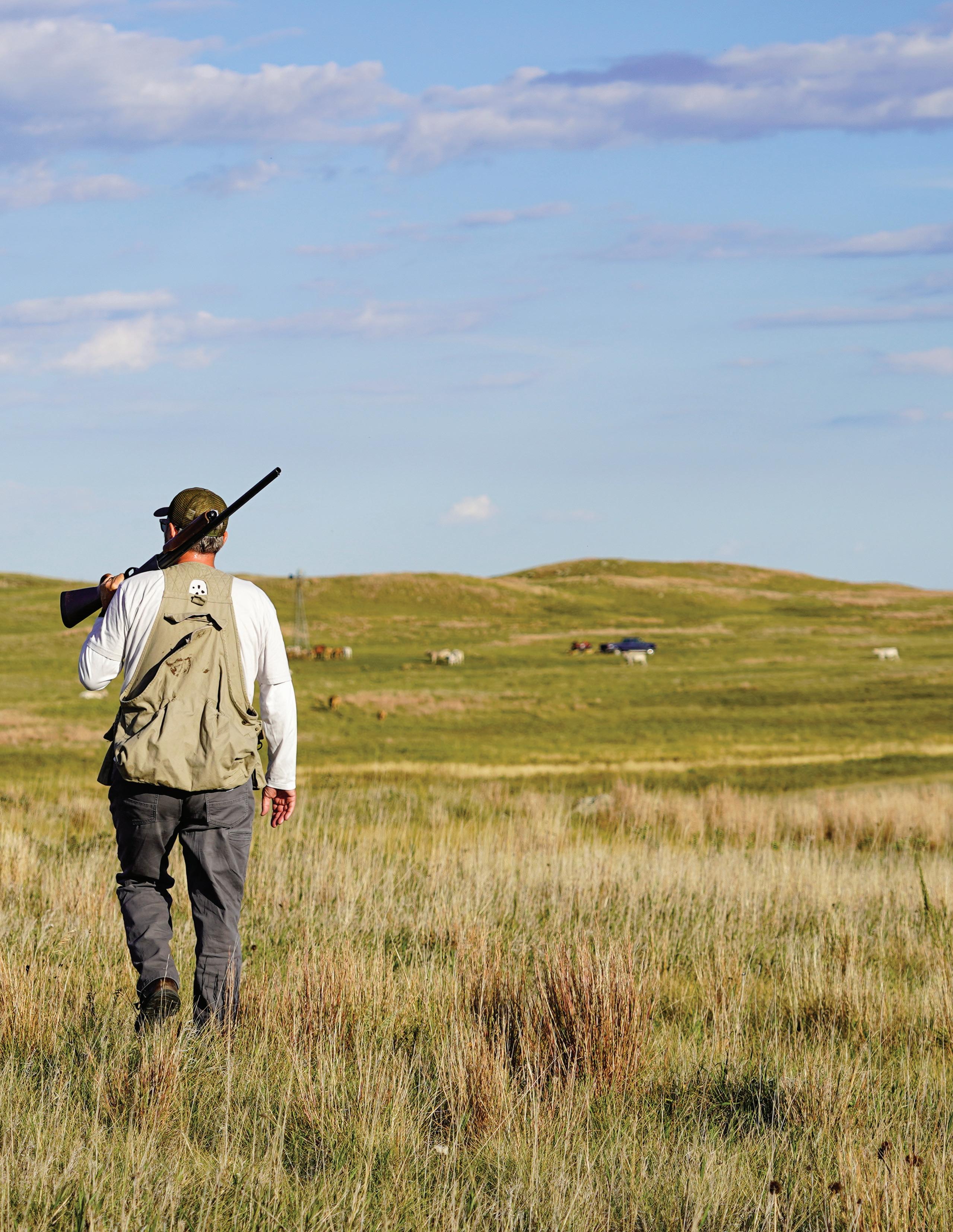
ND OUTDOORS ■ OCTOBER 2022 ■ 11
Cattle grazing on trust land in central North Dakota.
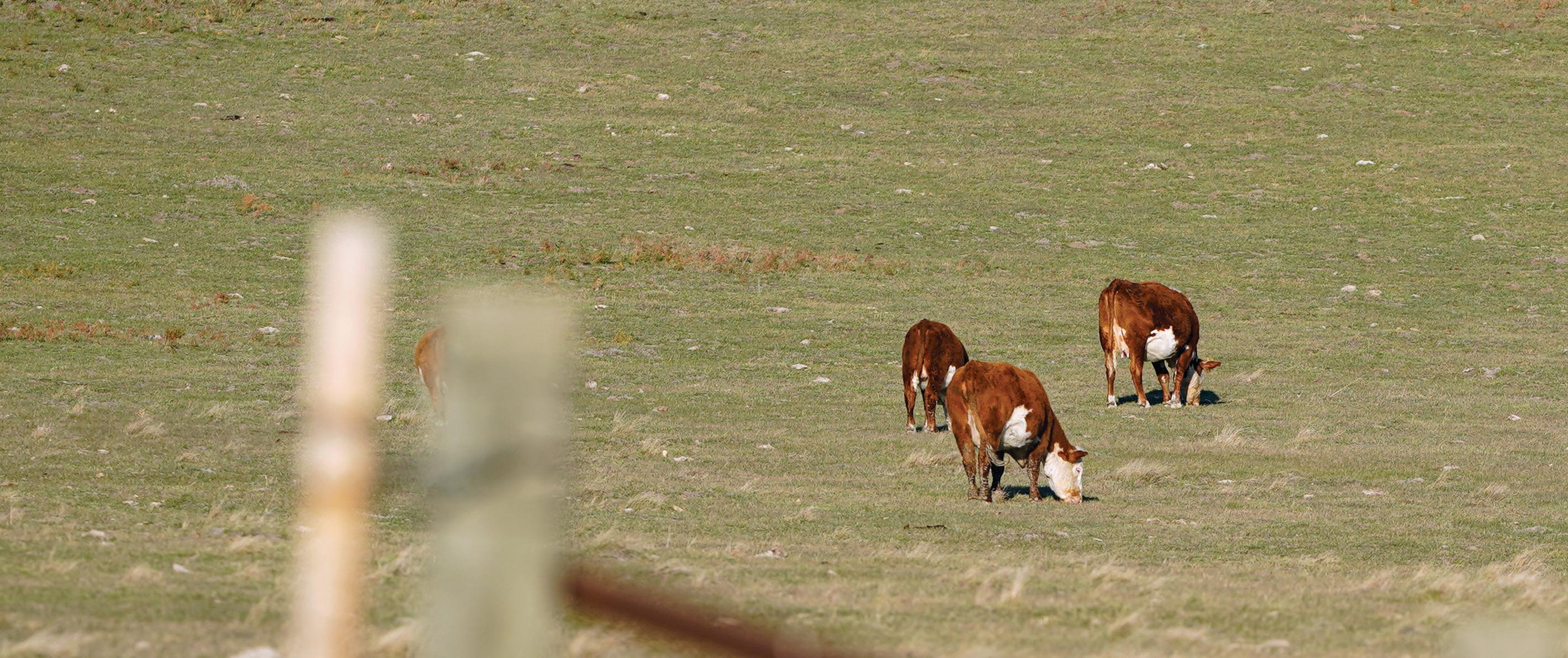
Today, Lardy said, the Department of Trust Lands man ages more than 706,000 surface acres across the state that are leased for agricultural purposes, with livestock grazing
Not all public land looks the same, said Casey Anderson, North Dakota Game and Fish Department wildlife division chief, and it’s important that hunters understand that.

“Our mission, our goal on Game and Fish Department wildlife management areas is to create habitat and have a place to grow critters on the landscape that hunters can pursue,” he said. “I think people sometimes look at public land, no matter if it’s managed by the Fish and Wildlife Service, Bureau of Land Management or the Department of Trust Lands and think that it should look like one of our WMAs, but these different agencies have differing manage
These lands are dedicated to producing income for the trusts. The current public access policy has been in place sicne 1983 and public access is only allowable if it does not conflict with the constritutional mandate to produce
Lardy agreed: “Our land is out there for a specific mis sion and that’s to raise money for schools across North Dakota and in many instances that includes grazing. In the fall when you see our lands, they’ve been grazed through out summer and they’ll have less grass than a WMA.”
Even so, Anderson and Lardy echo, trust lands hold their share of wildlife, from sharp-tailed grouse to deer. Hunters who target the blue squares certainly know this.
“In the early 1980s, the land board adopted the current public access policy, which means these lands are open to walk-in access only unless it says closed otherwise,” Lardy
Trust land lessees do have the ability to post and close trust lands if they meet certain criteria.
“The main one being if they got grazing livestock on the land. The lessee can send in an application for closed signs, saying they have cattle grazing from this date to this date,” Lardy said. “And they can close down the section, or quarter, depending on how big the pasture is for that time. And once they take the cattle off, they’re supposed to take the signs downs and let me know that they’ve done so.”
Lardy said trust land lessees can’t use the typical “No

Hunting,” or “No Trespassing” signs that are common on the landscape.
“They have to be department-approved signs that will feature the name of the Trust Lands Department on the sign and the legal description,” he said. “I do run into that problem this time of year where lessees are using the wrong signs. So, I’ll call them and tell them they need to take those signs down and I’ll provide them the proper signage.”
Those lands posted “closed” to public hunting, Lardy added, are also “closed” to the lessee.
“That means the lessee can’t hunt that piece of trust land they are renting … it’s closed to everyone,” he said.
Lardy said only about 1.5% of the 706,000-plus acres of trust lands are typically closed but urges hunters to visit the Department of Trust Lands website (land.nd.gov) and do their homework before leaving home.
“We update that weekly this time of year or call in if you don’t have access to a computer and I can tell you if a piece is closed or not,” he said. “I just don’t want anyone to be surprised when they pull up and it’s closed.”
The Department of Trust Lands has another sign that’s different than simply “closed.” This “Notify the Lessee Before Entering” provides a legal description of the land
12 ■ ND OUTDOORS ■ OCTOBER 2022
and contact information for the person leasing the land.
“So, anyone who pulls up to trust land signed in this manner has to give reasonable notification by calling and the hunter and lessee can have a conversation,” Lardy said. “The hunter can say, ‘I’m going to be out here at this time with X number of people.’ And then the lessee can say, ‘OK, yeah, that sounds good.’ The intent of the sign is to set up a line of communication.”
Lessees who post this type of sign cannot prohibit access, Lardy said.
“If any hunters out there run into that, they can call our department and get in contact with me” he said.
With hunter-landowner relations top-of-mind, Anderson said the “Notify the Lessee” signs that connect these indi viduals is a good thing.

“It’s a benefit for the lessee to know who is out there on the land,” Anderson said.
While trust lands are walk-in access only, there are instances where vehicle travel is allowed. Even so, Lardy said, again, to do your research on the Trust Lands website to determine where you can drive and where you can’t.
“Anybody can walk across all acres of trust land. With that said, you can drive on trust land if it’s like a county road that would have a public easement going through the section,” he said. “If it’s a section line, people can drive on section lines if they’re travelable. And there are a few instances where there are twotrack trails, primarily in the badlands, I believe, and those have public ease ments that Game and Fish obtained from our department and those are open to the public to drive across and those trails will be signed.
“If any hunters are out there and they’re seeing a two-track trail across trust lands and there’s no sign, they can prob ably assume that it’s a private trail that’s unique to
our department and our lessee,” Lardy added. “Lessees are able to drive on trust lands for agricultural purposes, such as checking on their cows. So, you’re going to see twotrack trails across trust lands, but if there is no sign for that, it’s not open to public travel.”
Anderson said the Game and Fish Department often field calls about the management of trust lands and how the Trust Lands Department oversees grazing manage ment.
Lardy said his department doesn’t allow feeding on trust lands, and in terms of actual grazing management, they let the lessees do what works for their operation.
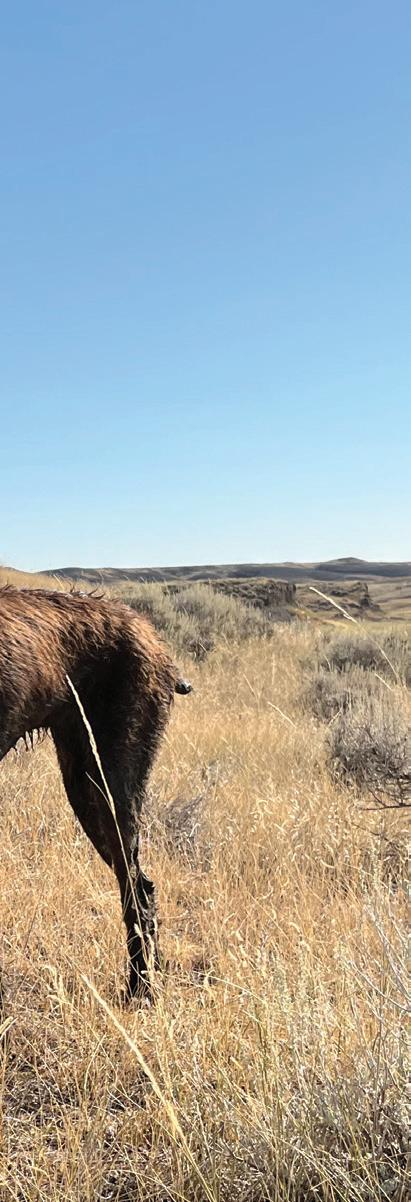
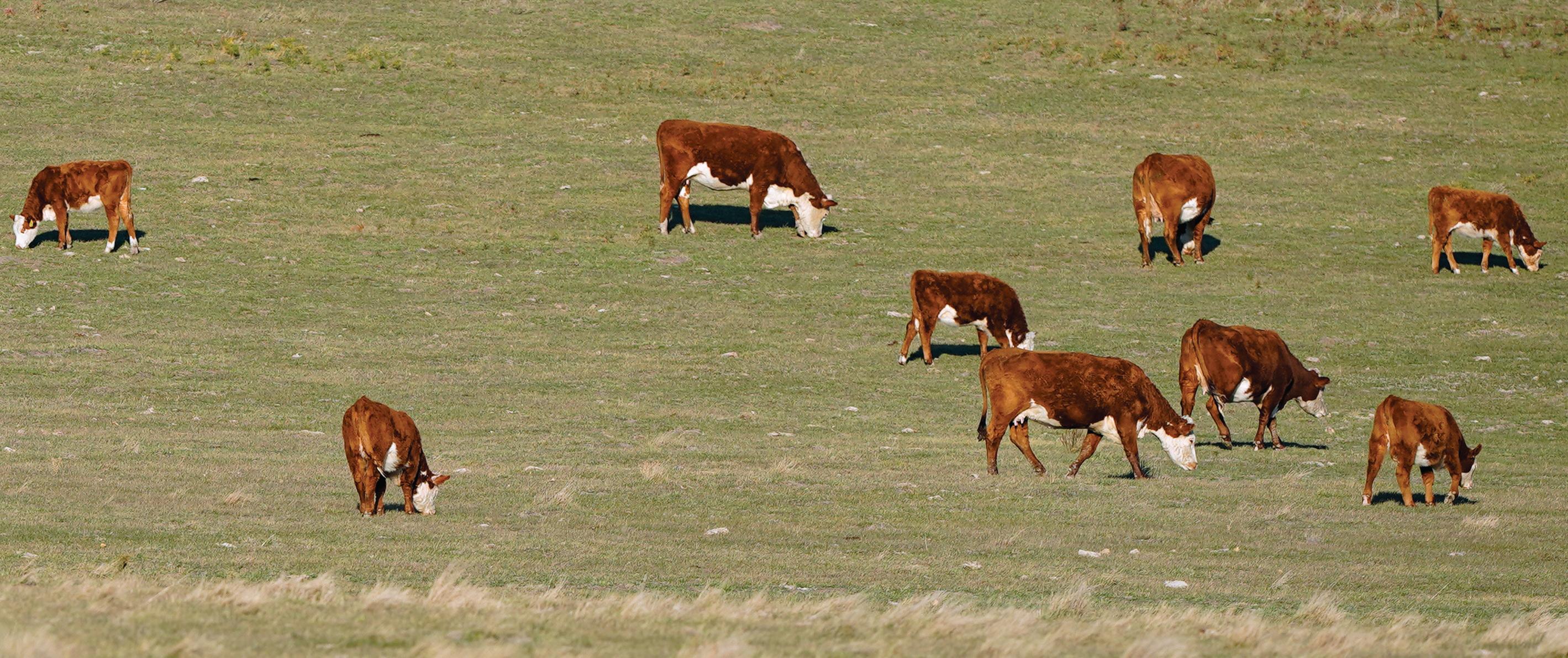
“With that said, we do check on all our tracks and if we need to, we will step in and work with the lessee on a graz ing plan,” Lardy said. “We have field inspectors scattered across the state and they do what we call integrity inspec tions, so each track of land is on a rotation, and it gets looked at and scored once every five years based on our scoring system.
“Our field inspectors look at a number of things while they’re out there, including plant vigor and how the tract is used. Typically, in a given year, there’s about 1,000 inspections that happen,” he added. “And once we get all those inspections back, we pull the lower numbered ones (inspections) and then I’ll look more into the comments of what the field inspectors saw at the time. Then that follow ing summer I’ll go out and verify myself if I think a tract has been overused, if it’s been overused for a number of years, then I’ll step in. Ideally, we’d like to catch those before it’s detrimental to land. But yeah, we do step in, and we do have tracts with grazing plans on them, but not every tract of land does.”
The blue squares, sections 16 and 36, teamed with other public lands in North Dakota provide some variety and a number of opportunities for hunters in the state, Anderson said.
“North Dakota is fairly privately owned, but there are a lot of gems across the landscape when you get out and start looking around at our public lands,” he said.
RON WILSON
CAYLA BENDEL
Hunting sharp-tailed grouse on the blue squares.
ND OUTDOORS ■ JULY 2022 ■ 13
What do a giant anvil in an alfalfa field, an ammo can stuffed with loot in a shelter belt and a pneumatic tube hidden next to a historic train station have in common? They’re all part of a worldwide treasure hunt. And they’re all right here in North Dakota.
North Dakota is a geocaching hot spot. Its unlikely star attraction is Gilby, a proud little farming commu nity northwest of Grand Forks. This tiny town is known as the Disneyland of Geocaching, thanks to a series of brainteasers created by Chad Thorvilson, an expert cache maker who goes by Trycacheous in the geocaching com munity.
Visitors drive here from surrounding states and Cana dian provinces to the north and west. They fly in from Texas, Alaska and Hawaii. They stop to look for goodies stashed in North Dakota state parks, to find trinkets at historical sites near the Canadian border, and to try a citywide treasure hunt in Fargo-Moorhead. There are geo caches in every major city in North Dakota and at least one cache in all the state’s 53 counties.
But if you’re like many North Dakotans, you had no idea. You drive right by concealed caches, oblivious, mistakenly certain that you know your own neighborhood inside and out. You assume there are no surprises in this familiar landscape, no mysteries to be found, and cer tainly no hidden treasure. But you’re wrong.
That changes now. This is your initiation into the world of geocaching, an addictive pastime and thriving subcul ture with deep roots in North Dakota.
WHAT IS GEOCACH IN G?
Geocaching is an outdoor activity, a treasure hunt, a global game of hide and seek. Seekers called geocachers use a Global Positioning System receiver, mobile phone or other navigational tools to find containers (called caches) hidden at specific coordinates across the globe –and beyond.
“There’re 191 countries that have geocaches,” said Thorvilson. “There are over 3 million of them in the world. There was even a trackable tag put on the Mars Rover.”
The accuracy of modern GPS technology improved immensely on May 2, 2000. GPS enthusiasts (and fans of orienteering and older forms of navigational scaven ger hunts like wayfaring and letterboxing) took notice. The very next day, a man named Dave Ulmer decided to see just how accurate this new GPS technology was. He placed a bucket in the woods in Oregon and listed the coordinates online. It was found within days and geo caching was born.
HIDDE
IN PLAIN SIGHT
By Alicia Underlee Nelson
HOW DOES GEOCACHING WORK?
The rules of geocaching are simple. Follow the GPS coor dinates and written clues to find a cache. Sign the log, take a trinket, and leave one of equal or greater value.
Then put the cache back exactly where you found it. Use stealth to avoid drawing attention from nearby “muggles” (nongeocachers) who might be curious about why you’re poking around along the tree line or nonchalantly reaching behind a road sign. Don’t worry about trespassing – cache hiders need to get permission from landowners before placing a find on their property.

14 ■ ND OUTDOORS ■ OCTOBER 2022
HIDDEN
HOW DO I START?
Download the official geocaching app or go to geo caching.com to look for coordinates to enter into your GPS device. The app is free and perfect for new and intermediate geocachers. (You can always pay to upgrade later if you want more features.) There are other geo caching apps out there, but this one is highly rated and extremely user-friendly.
Search for caches by destination, or just center the map on your location to see what’s hidden nearby. Then grab a pen and a few prizes to trade and you’re ready to go. You probably won’t have to travel far.
START CLOSE TO HOME
Tanya Harmon started geocaching about 20 years ago, back when treasure hunters had to go online and print out a map. By the time her son, Devin, 14, and daughter, Riley, 12, were ready to try geocaching, this West Fargo family could just grab a phone and hit the road.
“I wanted to find something to get the kids out of the house and something that both kids would enjoy,” Tanya Harmon said. “So, we went to Lindenwood Park the first time.”
The Harmons logged a handful of caches at that Fargo park on their first attempt. Riley and Tanya have found a few more around the state, including some in Grahams Island State Park near Devils Lake. But Riley’s favorite is just a few blocks from home.

“There was one behind Costco that I did with my mom that was really fun,” she said. “We had to find a combination to a lock. I like how some of them have a mystery to solve and you have to look around for clues.”
START WITH EASY FINDS
Like Tanya Harmon, Mark Elton started geocach ing with a computer and a paper map. The Moorhead, Minn., resident frequently brings friends (and brand new geocachers) across the border to search for caches in Fargo.
“For people who are just starting out, definitely use the filter on the app,” he said. “Go for the easy ones first.”
This isn’t as hard as it sounds. When you download the free app, it only shows you the easier caches. Premium users who pay a monthly or annual fee to upgrade can filter by the difficulty of the cache or the terrain. Amy Schimetz, a geo caching enthusiast and interpreter/OLC coordinator at Lake Metigoshe State Park, explained the rating system.
“All geocaches are rated on difficulty and terrain on a 5-star rating (system), where one is easy and five is most dif ficult,” Schimetz said. “Difficulty rating refers to the difficulty level surround ing finding the container, whether you
ALICIA UNDERLEE NELSON
ND OUTDOORS ■ OCTOBER 2022 ■ 15
You never know what you’ll find while geocaching in North Dakota.
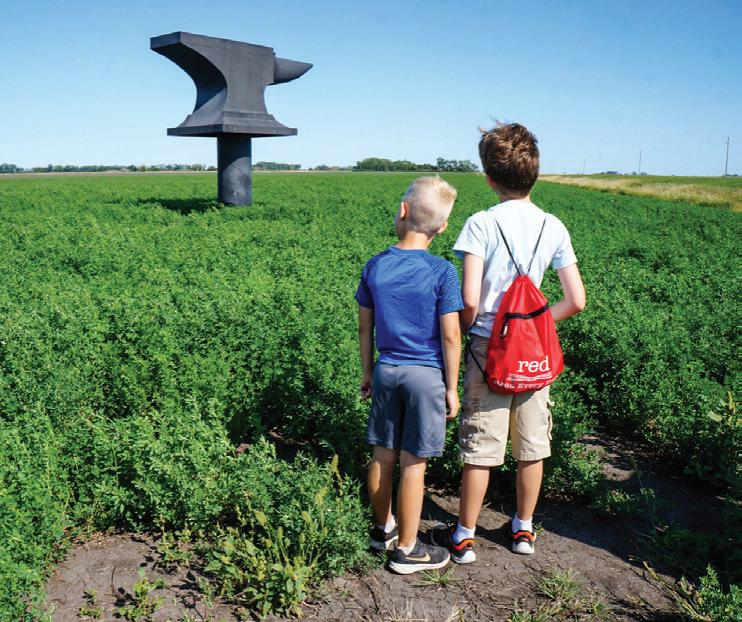
are solving a clue, looking for a camouflaged cache or even needing specialized knowledge or skills to find, solve or open a cache. Terrain refers to the physical effort needed to arrive at the cache location. A terrain level of one would likely be paved and accessible by a wheelchair, whereas a five would require special equipment such as scuba gear, rock climbing gear, a boat, etc.”
Very high terrain ratings aren’t common in the Midwest, especially in North Dakota where the landscape is flat. (I haven’t seen anything higher than a three so far.) Many caches are tucked into city parks and located near attrac tions where parking is plentiful. Some are actually hidden in parking lots.
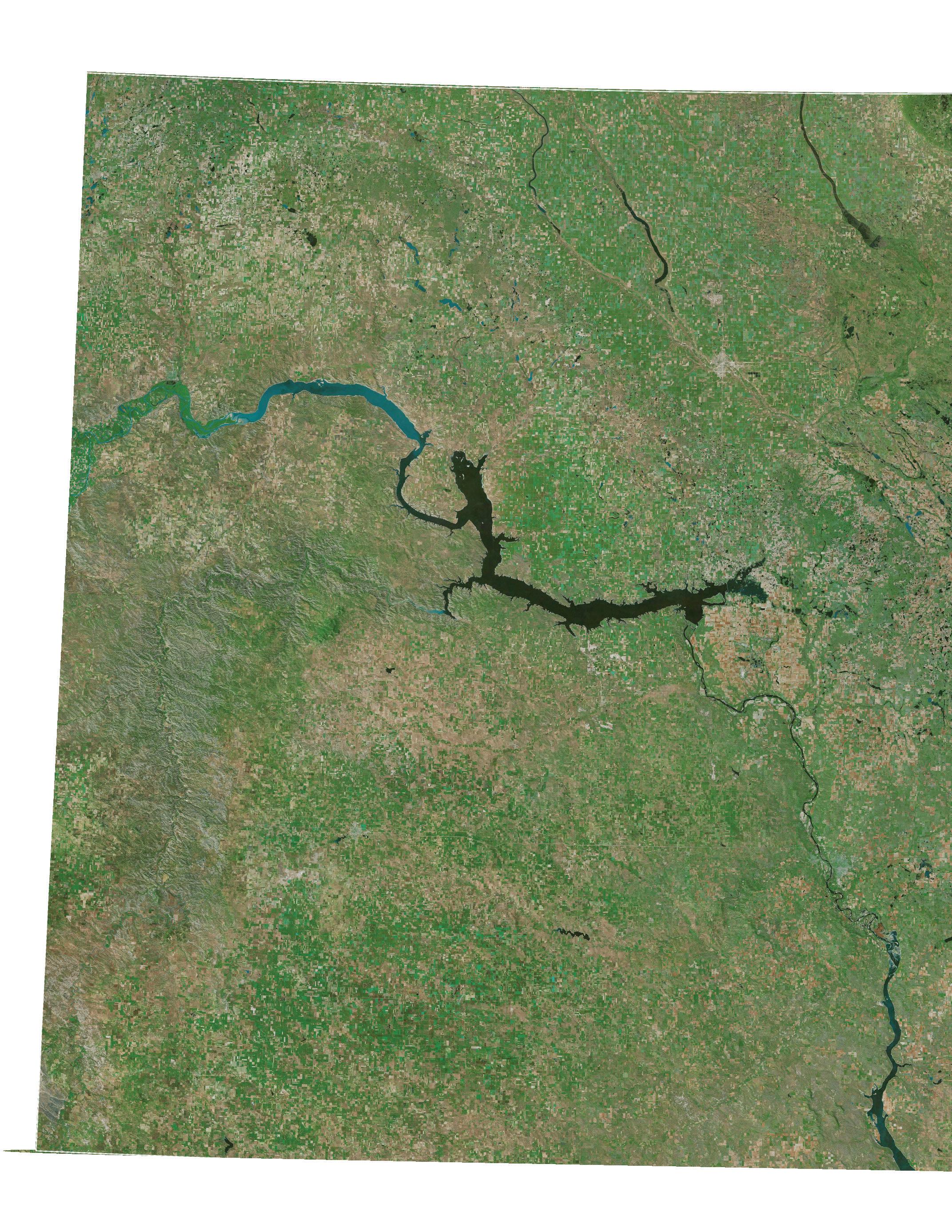
USE YOUR SKILLS (AND BRING A TEAM)
Your geocaching app will get you within a few feet of the treasure. But it’s up to you to find it.
“Once you get to that spot, start looking around,” said Chad Thorvilson. “It could be hanging from a branch or at the bottom of a tree. A lot of times it will be stuck in a hole in a tree somewhere. In town, usually they’re a lot smaller. People will disguise them as fake electrical plates on posts, things like fake reflectors, lamp skirts at the bottom of the lamp pole – people will put geocaches underneath that cover. There’s a lot of creative ways to hide caches in town.”
Hunters, birdwatchers and hikers have an edge when it comes to finding caches in nature. It’s easier to notice where
the grass is trampled down or see where the terrain is disturbed if you’ve had practice.
Once you find the cache, you have to open it. Some times this is straightforward; you open the container, sign the log, note your find, and take and leave a prize.
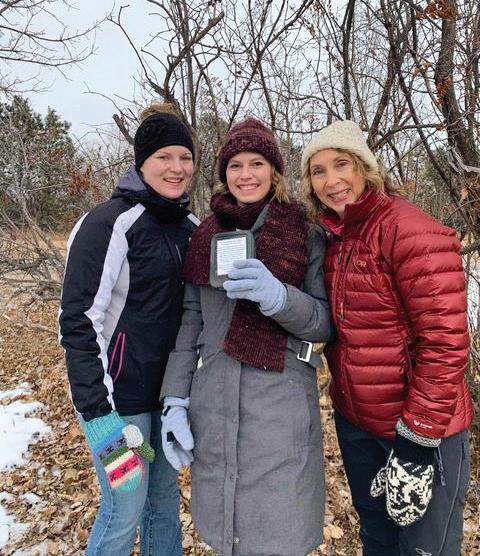
But some caches are mini puzzles. And just like when you’re locked into an escape room or solving the daily crossword, consulting with people who have differ ent skill sets and areas of expertise can increase your chances of success.
For example, my dad, Wayne, is a practical, DIY type. He’s my go-to guy for anything mechanical, unravel ing logic problems and opening advanced caches that require tools (see sidebar). My husband, Derrick, is a delivery driver with a head for numbers. He can remem ber long numerical sequences, find patterns, and identify urban caches in a flash because he looks at streetscapes all day long. I’m good at mining the cache description, previous activity, and hints (all provided in the app) for tips and tricks. My knowledge of spy thrillers and mystery novels has also been surprisingly helpful when solving riddles and cracking codes.
Kids and teenagers are excellent team members, too. My nephew, Tristan, 15, is analytical and persistent, so he takes the lead on riddles and ciphers. His sister, Bella, 13, can finesse any lock, while little brother, Drew, 9, has eagle eyes that spot caches that the rest of us walk right by. My son, Eli, 9, has a knack for visual clues and fishing caches out of small spaces.
So, bring a group and try your luck. And remember, it’s supposed to be a challenge.
STICK WITH IT
“Don’t get too frustrated if you don’t find anything in the first 5 min utes,” said Devin Harmon. “And bring water.” (This is sound advice. New geocachers some times forget basic outdoor safety tips like staying hydrated, wearing proper clothing, and applying sun screen.)
“The camouflage can get really tricky sometimes,” said Mark Elton. “There are a lot of different types of caches. Pill bottles and ammo cans are very common, but there are also magnetic key holders and false mag netic electrical plates. But if you’ve never come across a false electrical plate, you’ll just walk by it. So, the more you go geocaching and the more variety of caches you find, the easier it becomes.”
16 ■ ND OUTDOORS ■ OCTOBER 2022
GO FOR THE BIGGER PRIZES
Kids of all ages (even the grown-up ones) get a kick out of a prize every now and then. So, skip the micro caches at first and concentrate on larger containers.
“If I’m going to get people to go geocaching and all we find is a tiny little pill capsule with only enough room for a log, that’s not as interesting as if I pull out an ammo can or a treasure chest full of little treats,” said Elton. “With a big ger cache, kids can pull out a little toy. And sometimes they can even find money, so it’s a lot more rewarding.”
Bring your own prizes to replace what you take. Small items like pencils, erasers, coins, keychains, and little toys work well. So do paper products like bookmarks and stick ers, especially if they’re encased in plastic to protect them from the elements. Don’t leave food, liquids, illegal or adult items or weapons behind.
Once you’ve gotten the basics down, you’re ready to challenge yourself. Find cool caches in your area, earn sou venirs on the app or take a geocaching road trip.
EARN SOUVENIRS
Geocachers get souvenirs (virtual badges) for logging finds on the app and online. But you can also get one for finding a cache during World Geocaching Day (August 20) or Blue Switch Day (May 2), the date that more accurate GPS technology became available to civilians.
You can earn souvenirs for geocaching in different cit ies and countries, too. So, throw in a few trinkets when you’re packing for your next hunting trip or family vacation.
Geocaching is an immersive way to get to

know a new place. And it makes stopping for food, fuel and bathroom breaks along the way a lot more interesting.
GO GEOCACHING IN NORTH DAKOTA STATE PARKS
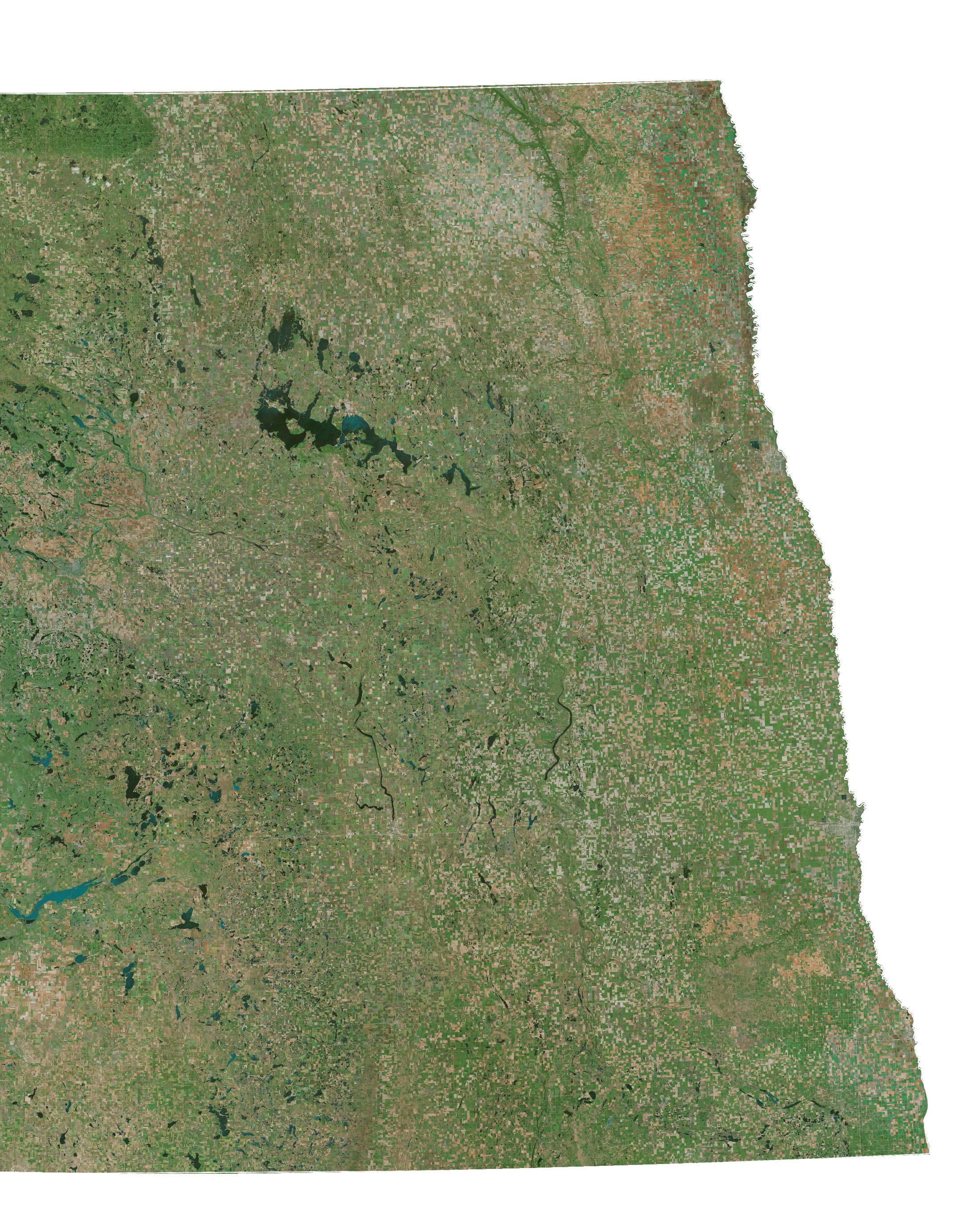
You don’t have to travel out of state to find a new geocaching challenge. Eight of North Dakota’s 13 state parks have geocaches within their borders. They include Cross Ranch State Park and Fort Stevenson State Park along the Missouri River, Lewis and Clark State Park in the northwest and Fort Ransom State Park in the southeast.
The northeastern corner of the state boasts four of the most popular geocaching parks. Grahams Island State Park outside Devils Lake, Icelandic State Park near Cavalier, Turtle River State Park northwest of Grand Forks and Lake Metigoshe State Park along the North Dakota-Manitoba border attract geocachers from both the U.S. and Canada. The scenery is a draw. So is the concentration of caches.
“Geocaching within a couple of our parks offers a cluster of caches that can be found in a smaller, local area,” said Schimetz. “For example, Lake Metigoshe and Turtle River state parks each offer 10 caches and Icelandic State Park currently has five caches hidden within its boundaries. A trip to these locations will be more than worth it for a cacher looking to add to their list of total caches found.”
Geocaching in a state park is a low stakes way to intro duce people to the hobby since there are other activities available. It can also help families go deeper into nature and see a familiar park in a new way. The North Dakota Geo caching Association offers monthly state park geocaching hikes. Newcomers are welcome.
FIND NEW KINDS OF CACHES
Once you’ve found a few traditional caches, you’re ready to try a few new cache types. It helps to understand the dif ferences between them.
“So traditional is just you go out there and find it,” said Thorvilson. “Then there’s puzzle caches, where you might either try to figure out the coordinates or it’ll be a puzzle on how to open it. Then there are multi-caches, which bring you to one spot and then you will find the coordinates or something to point you to the next spot. Earth caches are all about unique spots in the world.”
ND OUTDOORS ■ OCTOBER 2022 ■ 17
Some caches include multiple stops that create a kind of quest. For example, to complete the North Dakota Chal lenge, you need to log a find in each of the state’s 53 coun ties. To complete the Bingo Series near Jamestown, geo cachers need to find all of the bingo numbers in 75 different caches. The map of their locations spells out BINGO.
Adventure Labs are visible on a separate Adventure Lab app and also on the Geocaching app, where they also count toward your overall finds. In an Adventure Lab, participants move through a virtual treasure hunt instead of hunting for a physical object. There are Adventure Labs in several state parks, including Cross Ranch, Fort Ransom, Fort Abraham Lincoln, Fort Stevenson, Icelandic, Lake Metigoshe and Turtle River.
FARGO-MOORHEAD GEOTOUR
You can also try a GeoTour. One of the best in the nation is right here in North Dakota.

Coordinator Gia Ressler (aka, Giacaches, in the geocach ing world) worked with cache creators (including Thorvil son) and local artists to create 24 unique caches hidden in and near tourist attractions, parks and quirky neighborhood spots in Fargo, Moorhead and West Fargo.
The caches are clever enough to captivate veteran geo cachers. But they welcome new geocachers, art fans and

travelers as well. Find 20 caches and enter in the codes posted on each cache and you’ll receive a Geocoin from Visit Fargo-Moorhead.
You can search for the Fargo-Moorhead GeoTour in your app by entering GT488. Visit Fargo-Moorhead also promotes the tour by handing out paper copies of the tour’s stops at its headquarters just off 45th Street in Fargo. You can also download a passport at fargomoor head.org/things-to-do/geocaching/ before you arrive in town.
“What I like about the GeoTour is that it becomes a guided experience,” said Elton, who loves to take visitors on the Fargo-Moorhead GeoTour. “They put together a whole one-sheet listing of all the caches, which makes the hunt more tactile. You can hand people the sheet and then say, ‘Okay, which one do you want to find?’”
PEMBINA WALSH HISTORIC TRAIL
Other North Dakota destinations are think ing outside the box to connect geocaching and tourism as well. The Pembina Walsh Historic Trail in northeastern North Dakota recruited Thorvilson to add gadget caches near some
Chad Thorvilson, an expert cache maker who goes by Trycacheous in the geocaching community.
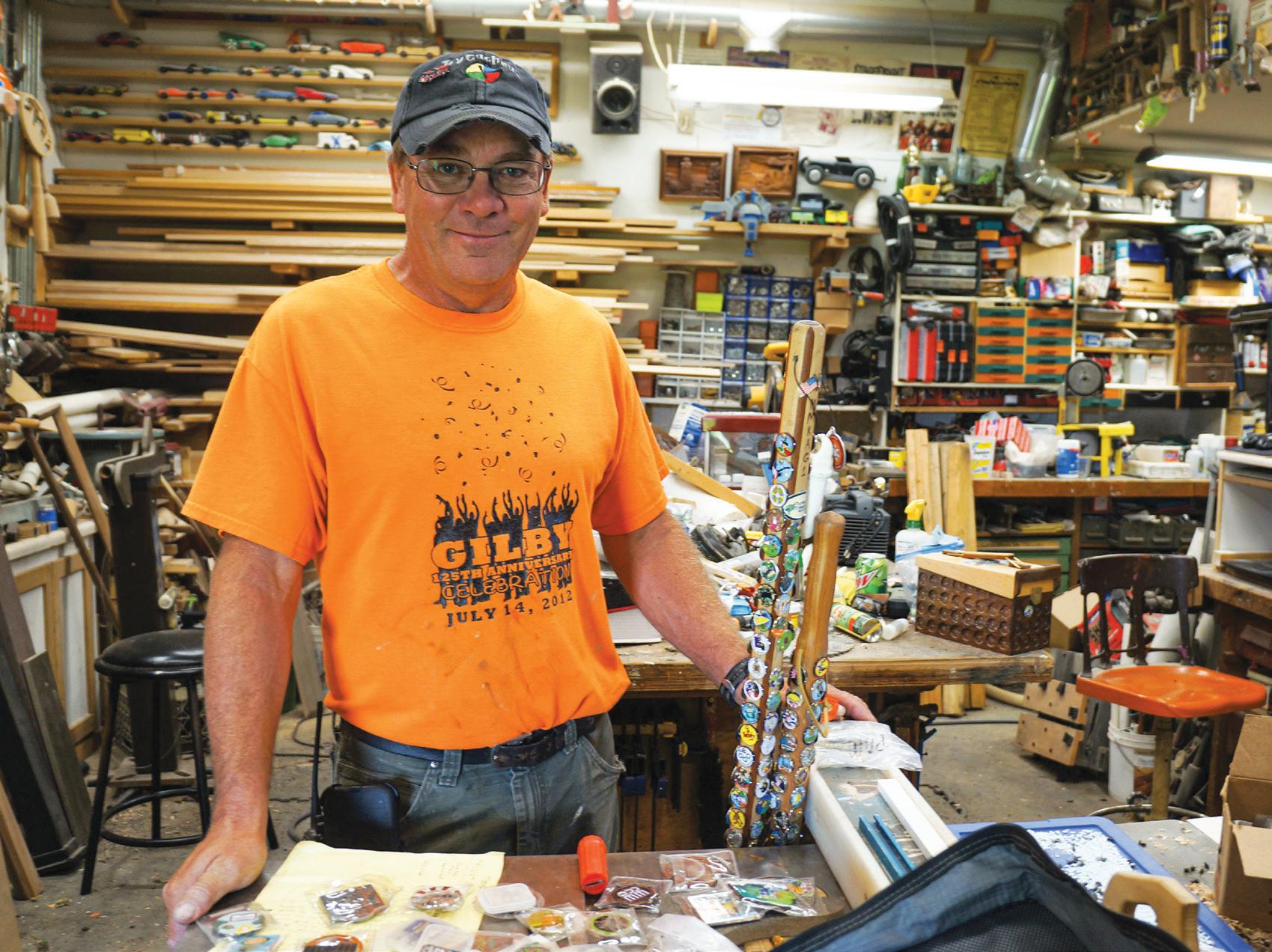
18 ■ ND OUTDOORS ■ OCTOBER 2022
the region’s histori
sites.
rendezvous
five
you
in
score
There are
three dozen caches
choose from.
way they’re rolled up into the history is just amazing,” said Thorvilson. “The fun caches are what draw people to North Dakota.”
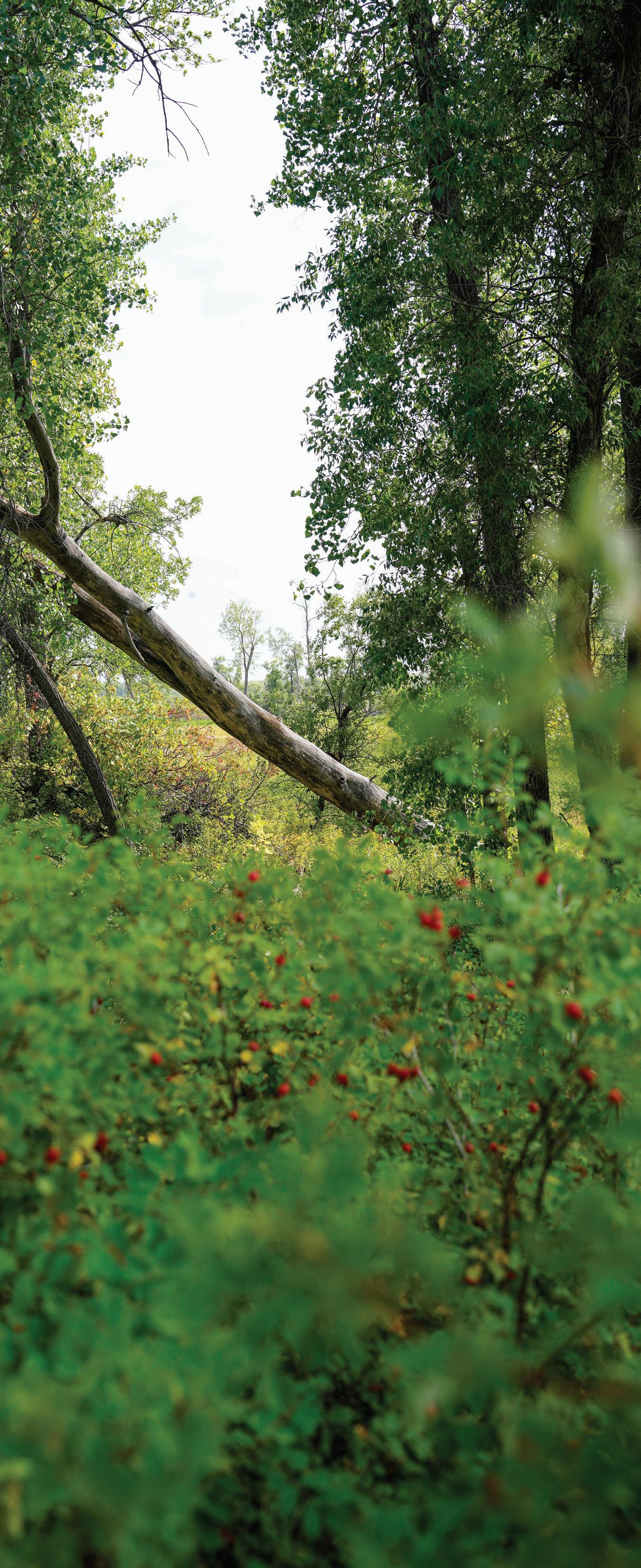
MAKE A PILGRIMAGE TO GILBY
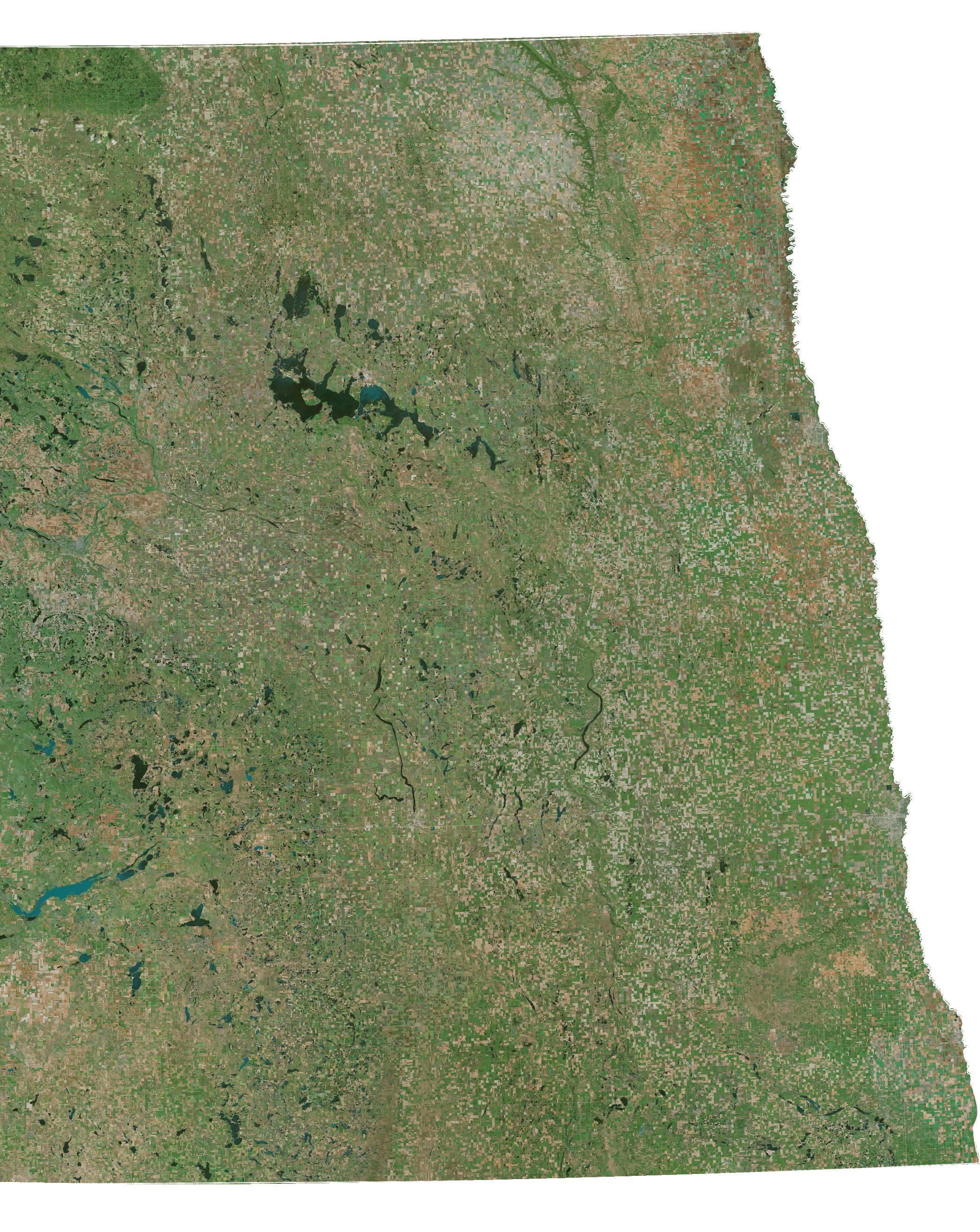
But no caches draw people to North Dakota quite like Thorvilson’s caches. There’s a reason that this cheerful, unassuming former Cub Scout leader is recognized at international geocaching events, profiled by geocaching YouTubers and greeted with squeals of delight by complete strangers who leap out of their cars to shake his hand outside of the Gilby farmhouse he shares with his wife, Jane.
“The caches I have found there have been so beau tifully gamified that it spoils every other cache,” Elton said. “It’s hard to find caches that are that good.”
They’re also cheeky, clever and occasionally laugh out loud funny. Like a good mystery novel, these caches include plenty of red herrings and witty word play. Some require you to throw a baseball, arrange magnets, or use robotics. In one, you seek help from a Looney Tunes character. In another, you pick up a mallet and strike a piece of wood with all your strength, sending the cache soaring up into the air.
The Gilby caches are only visible to premium sub scribers, so they attract experienced geocachers. But it doesn’t matter if you ever make a pilgrimage to the Disneyland of Geocaching. When you find your first cache, you become a part of this secret community. And you’ll never see North Dakota the same way again.
ALICIA UNDERLEE NELSON is a freelance travel writer and photographer from West Fargo. She blogs frequently about travels within North Dakota on her website, prairiestylefile.com.
WHAT YOU NEED TO GET STARTED
HANDY TO HAVE
TOOLS FOR ADVANCED GEOCACHERS
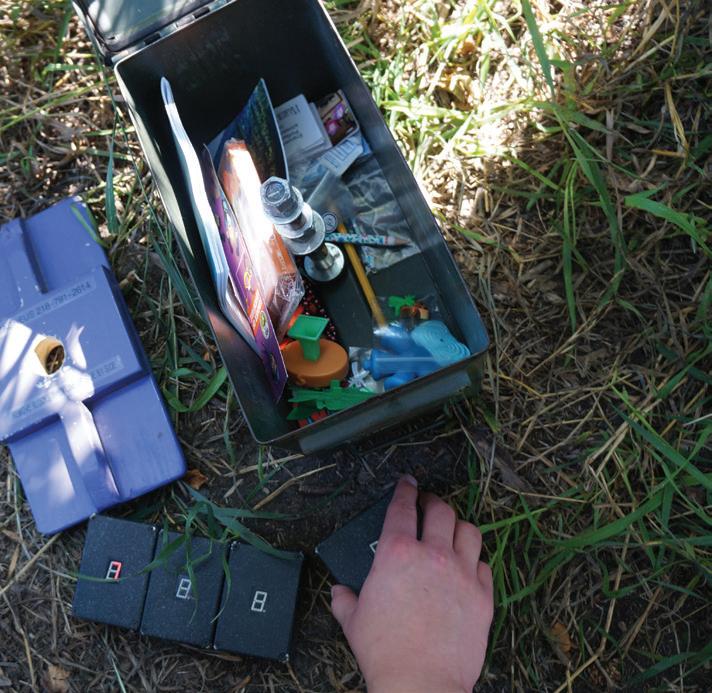
✓ A smartphone with the Geocaching app or a GPS unit and website access ✓ Pen or mechanical pencil ✓ Small prizes and trinkets
✓ Water ✓ Sunscreen, hat and raingear ✓ Scratch paper ✓ Bug spray ✓ Snacks
✓ Screwdriver ✓ Telescopic magnet ✓ Flashlight ✓ Tape measure (12 feet or longer) ✓ Crescent wrench ✓ Plier ✓ Tweezers of
cal
Geocachers can go to
region.com/down load/passport.pdf to download the PWHT passport. When
log
finds
each county, you’ll
two commemorative pathtags.
over
to
“The
ALICIA UNDERLEE NELSON
ASHLEY PETERSON
ND OUTDOORS ■ OCTOBER 2022 ■ 19
BUFFALOBERRY PATCH
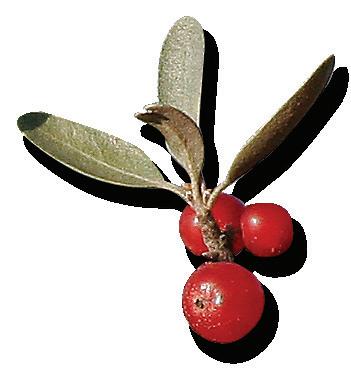
areas, particularly if the fall remains hot. Although the densities were highest in the southwest, the relative trends remain highest in the prairie potholes along the Missouri River.”
Sharptails observed per 100 miles were down 30% statewide. Brood survey results show observers recorded two sharptail broods and 13 sharptails per 100 miles. Average brood size was six.
Generally, Kolar said, most of the partridge harvest is incidental while hunters pursue grouse or pheasants. But this year, with partridge numbers looking impressive, he said there may be pockets where hunters could focus primarily on partridge.
Upland Game Brood Survey Results
North Dakota’s late summer roadside surveys indicated pheasant and gray partridge were up from last year, while sharp-tailed grouse numbers were down.
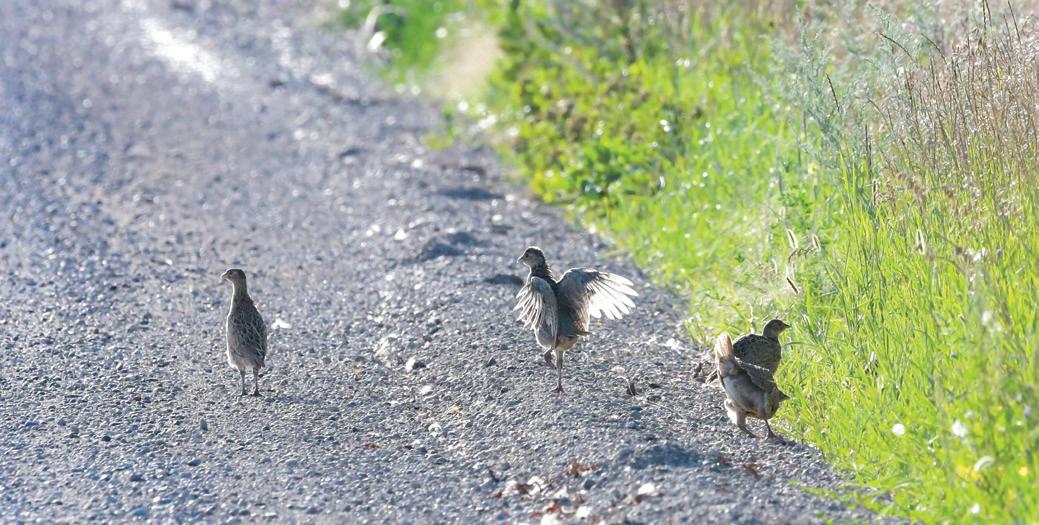
Jesse Kolar, Game and Fish Department upland game supervisor, said the annual upland counts showed mixed results.
“We observed an increase in pheasant and partridge densities and reproductive rates with average brood size and age ratios, while sharptails decreased in density but had improved reproductive rates from 2021,” he said.
Total pheasants observed (49 per 100 miles) were up 9% from last year and broods (5.3) per 100 miles were up 8%. The average brood size (6.2) was up 7%. The final summary is based on 278 survey runs made along 100 brood routes across North Dakota.
Observers in the northwest counted 11 broods and 96 pheasants per 100 miles, up from eight broods and 68 pheasants in 2021. Average brood size was six.
Results from the southeast showed five broods and 39 pheasants per 100 miles, up from three broods and 24 pheasants in 2021. Average brood size was five.
Statistics from southwestern North Dakota indicated five broods and 48 pheasants per 100 miles, down from six broods and 59 pheasants in 2021. Average brood size was five chicks.
The northeast district, generally containing secondary pheasant habitat with lower pheasant numbers compared to the rest of the state, showed two broods and 18 pheasants per 100 miles, compared to three broods and 24 pheasants last year. Average brood size was seven.
Kolar said sharptail hunters should expect to find more hatch-year grouse this fall.
“The rangeland vegetation is significantly taller, and there will be many more areas to search to find grouse,” he said. “However, we have not had significant amounts of precipitation since mid-July, upland rangelands may not be as productive as hillsides or low-lying riparian
“Huns have rebounded, and the last time they were this good was in 2015,” Kolar said.
Partridge observed per 100 miles were up 46%. Observers recorded one partridge brood and 12 partridge per 100 miles. Average brood size was 10.
Five Bighorn Sheep Licenses
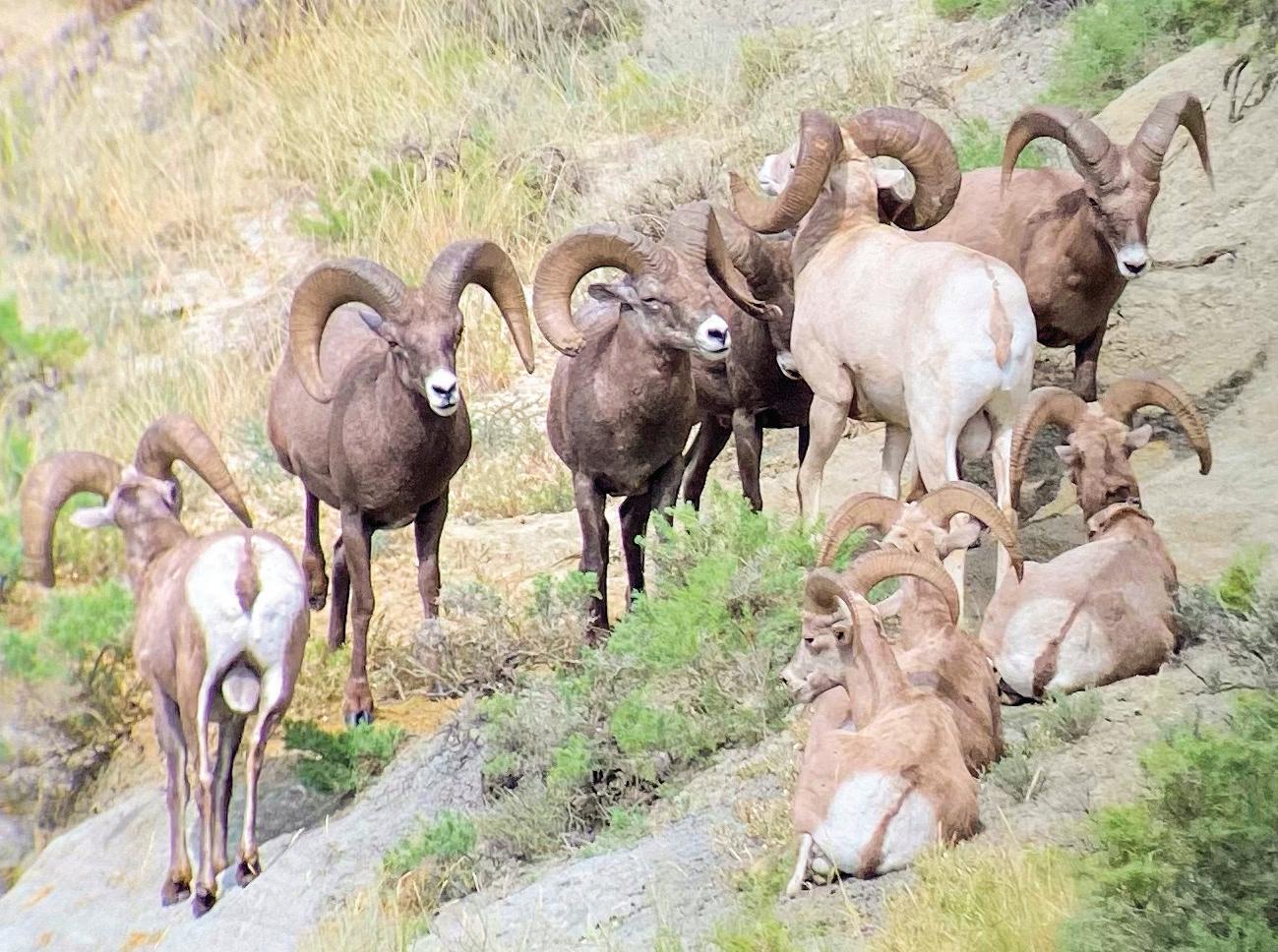
The North Dakota Game and Fish Department allocated five bighorn sheep licenses for the 2022 hunting season, the same as last year.
A record 19,423 applicants applied for bighorn sheep. Successful applicants have been notified. Prospective hunters were required to apply for a bighorn license earlier this year on the bighorn sheep, moose and elk application.
One license was issued in unit B1, one in B3, one in B4 and one in B5. In addition, one license, as authorized under North Dakota Century Code, was auctioned in May by the Midwest Chapter of the Wild Sheep Foundation, from which all proceeds are used to enhance bighorn sheep management in North Dakota.
SANDRA JOHNSON
BRETT WIEDMANN
20 ■ ND OUTDOORS ■ OCTOBER 2022
Pheasant brood on rural North Dakota road.
Bighorn sheep in the badlands.
Motorists Warned to Watch for Deer
Motorists should watch for deer along roadways this time of year as juvenile animals disperse from their home ranges.
October through early December is the peak period for deer-vehicle accidents. Motorists are advised to slow down and exercise caution after dark to reduce the likelihood of encounters with deer along roadways. Most deer-vehicle accidents occur primarily at dawn and dusk when deer are moving around.
Motorists should be aware of warning signs signaling deer are in the area. When you see one deer cross the road, look for a second or third deer to follow. Also, pay attention on roadways posted with Deer Crossing Area caution signs.
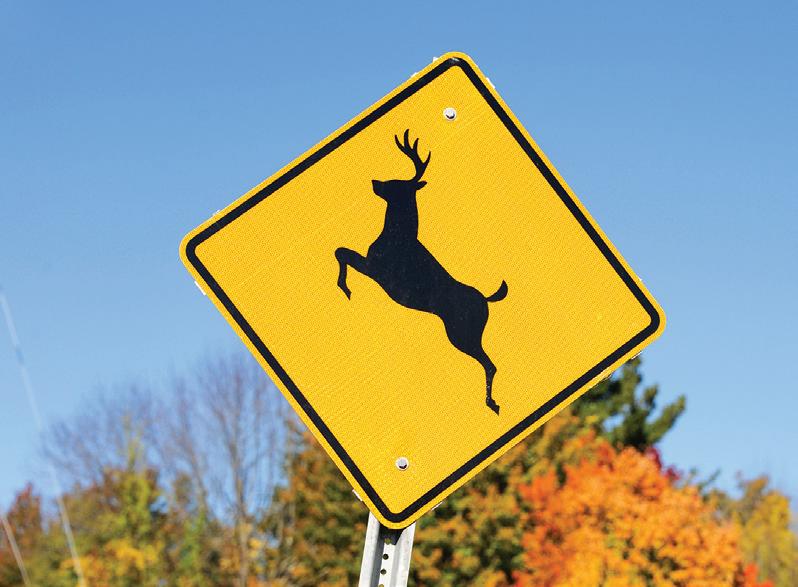
Deer-vehicle accidents are at times unavoidable. If an accident does happen, law enforcement authorities do not have to be notified if only the vehicle is damaged. However, if the accident involves personal injury or other property damage, then it must be reported.
In addition, a permit is required to take parts or the whole carcass of road-killed deer. Permits are free and available from Department game wardens and local law enforcement offices.
A few precautions can minimize chances of injury or property damage in a deervehicle crash.
• Always wear your seat belt.
• Don’t swerve or take the ditch to avoid hitting a deer. Try to brake as much as possible and stay on the roadway. Don’t lose control of your vehicle or slam into something else to miss the deer. You risk less injury by hitting the deer.
• If you spot deer ahead, slow down immediately and honk your horn.
Check Boat Lifts, Docks for ANS
The North Dakota Game and Fish Department is asking water recreationists and property owners to check for zebra mussels and other aquatic nuisance species when removing boat lifts, docks and other equipment from state waters.
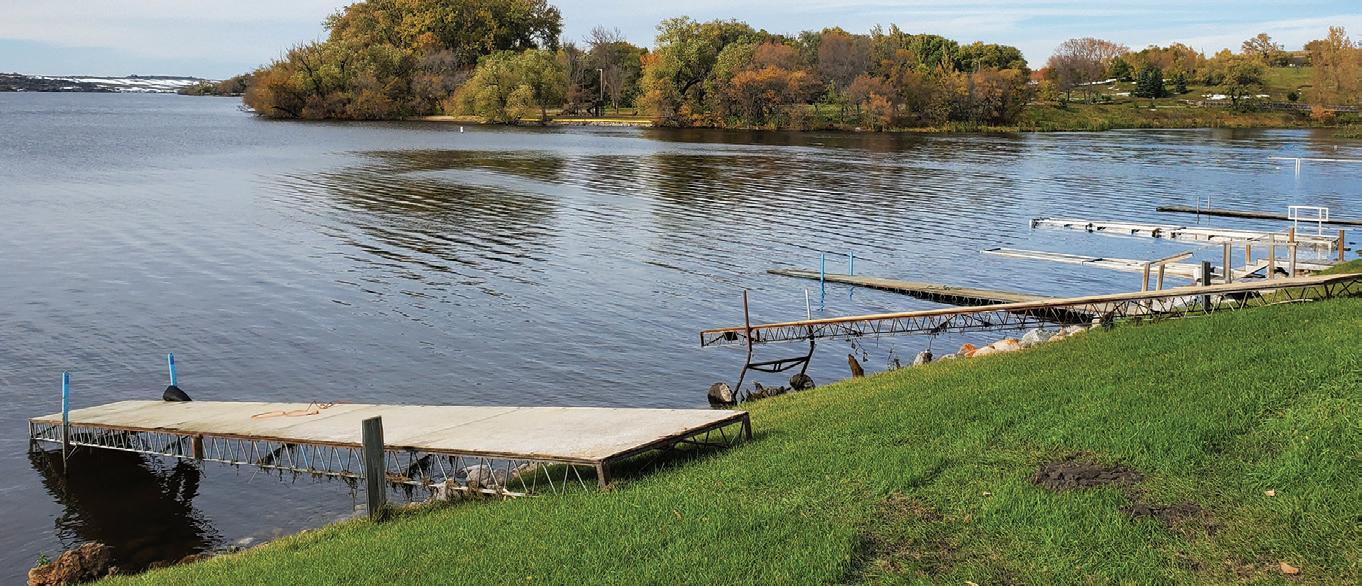
Ben Holen, Department ANS coordinator, said water recreationists and property owners play a vital role in ANS prevention.
Zebra mussels attach to hard surfaces that are left in the water for long periods of time, first settling in tight spaces and areas that are protected from sunlight, Holen said. Equipment such as boat lifts and docks are high risk vectors for spreading ANS, especially zebra mussels.
“It makes it easier to do a thorough search when equipment is taken out of the water in fall,” he said. “Pay special attention to wheel wells, right angles on frames, and areas otherwise protected from sunlight. Feel for attached organisms that have small hair-like structures holding them in place. Small mussels can feel like rough sandpaper and adults can be as large as 2 inches long.”
Holen said if you think you’ve found a zebra mussel, take photos, write down any relevant information, such as how many were found and where, and report it online at the Game and Fish website gf.nd.gov/ans, or email Holen at bholen@nd.gov.
Order 2023 OUTDOORS Calendars
The North Dakota Game and Fish Department is taking orders for its North Dakota OUTDOORS calendar, the source for all hunting season and application dates for 2023. Along with color photographs of North Dakota wildlife and outstanding scenery, it also includes sunrise-sunset times and moon phases.
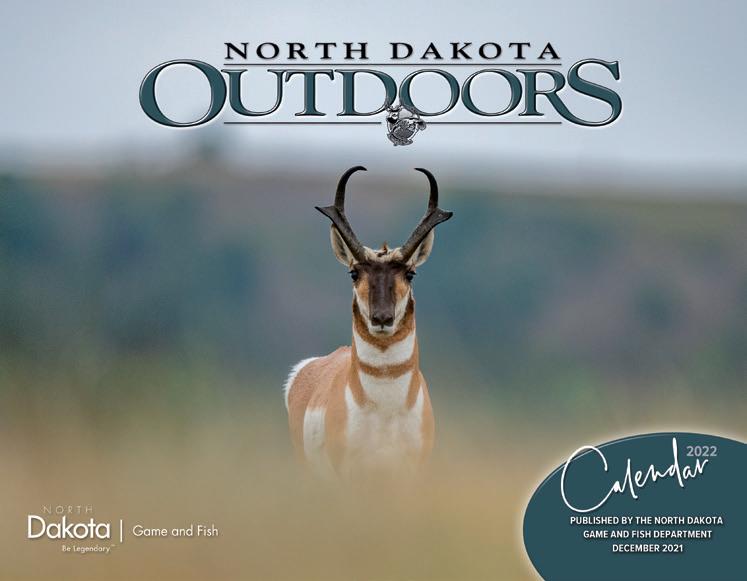
To order online, visit the Game and Fish website, gf.nd.gov., or send $3 for each, plus $1 postage, to: Calendar, North Dakota Game and Fish Department, 100 N. Bismarck Expressway, Bismarck, ND 58501-5095. Be sure to include a three-line return address with your order, or the post office may not deliver our return mailing.
The calendar is the magazine’s December issue, so current subscribers will automatically receive it in the mail.
MIKE ANDERSON ND OUTDOORS ■ OCTOBER 2022 ■ 21
Hunting from Duck Boats Safely
Waterfowlers hunting from boats are encouraged to wear properly fitted life jackets while on the water.
Hunting jackets with built-in life jackets are light and comfortable to wear. In addition, wearing a life jacket will not only keep the overboard hunter afloat, but also slows the loss of critical body heat caused by exposure to cold water.
Capsizing and falling overboard from small boats are the most common types of fatal boating accidents for hunters.
Permit Required to Possess Dead Deer
North Dakota Game and Fish Department enforcement personnel issues a reminder that a permit is required before taking possession of a dead deer found near a road or in a field.
Only shed antlers can be possessed without a permit.
Permits to possess are free and available from game wardens and local law enforcement offices.
In addition, hunters are reminded to properly dispose of dead deer. Deer carcasses cannot be left on the side of a roadway or in a ditch, and deer parts cannot be discarded in commercial dumpsters.
Whooping Crane Migration
Whooping cranes are in the midst of their fall migration and sightings will increase as they make their way into and through North Dakota over the next several weeks. Anyone seeing these endangered birds as they move through the state is asked to report sightings so the birds can be tracked.
Prepping for the Deer Gun Season
With North Dakota’s deer gun season opening in early November, many hunters will be looking for a place to sight in their firearms to get ready for the season.
The North Dakota Game and Fish Department manages five gun ranges on wildlife management areas in the state, and also partners with many local clubs around North Dakota to offer many other public shooting facilities.

The gun ranges managed by the Game and Fish Department include:
• Lewis and Clark WMA, located 6 miles southwest of Williston.
• Little Heart (Schmidt) Bottoms, located 12 miles south of Mandan off ND Highway 1806.
• MacLean Bottoms, located 2 miles south of ND Highway 1804, about 15 miles southeast of Bismarck.
• Riverdale WMA, located 2 miles southwest of Riverdale.
• Wilton Mine WMA, located 2 miles east of Wilton.
The Department may periodically close these ranges for routine maintenance and improvements. The status of each range can be found on the Department’s website at gf.nd.gov. The website also provides a detailed listing of other shooting facilities in North Dakota.
The whooping cranes that do make their way through North Dakota each fall are part of a population of about 500 birds that are on their way from nesting grounds at Wood Buffalo National Park in Canada to wintering grounds at Aransas National Wildlife Refuge in Texas, a distance of about 2,500 miles.
Whoopers stand about five feet tall and have a wingspan of about seven feet from tip to tip. They are bright white with black wing tips, which are visible only when the wings are outspread. In flight they extend their long necks straight forward, while their long, slender legs extend out behind the tail. Whooping cranes typically migrate singly, or in groups of 2-3 birds, and may be associated with sandhill cranes.
Other white birds such as snow geese, swans and egrets are often mistaken for whooping cranes. The most common misidentification is pelicans, because their wingspan is similar, and they tuck their pouch in flight, leaving a silhouette like a crane when viewed from below.
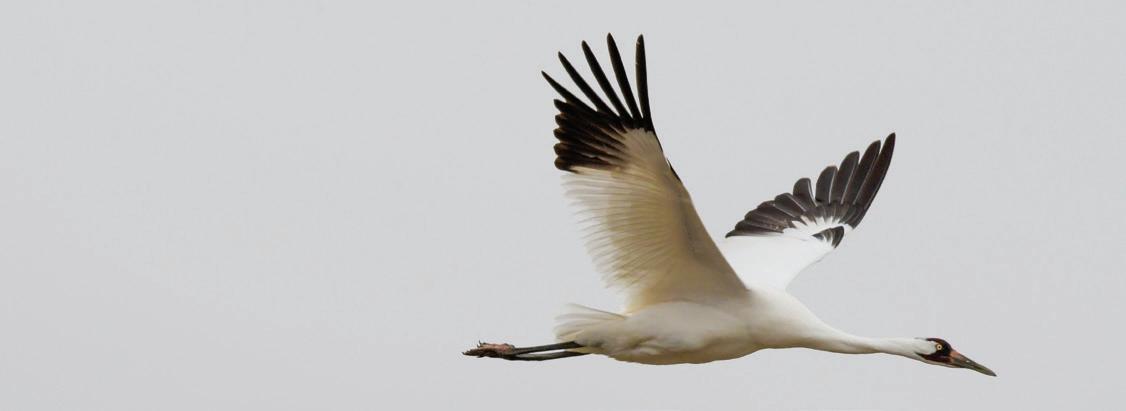
Anyone sighting whoopers should not disturb them, but record the date, time, location and the birds’ activity. Observers should also look closely for and report colored bands which may occur on one or both legs. Whooping cranes have been marked with colored leg bands to help determine their identity.
Whooping crane sightings should be reported to the U.S. Fish and Wildlife Service offices at Lostwood, 701-848-2466; Audubon, 701-442-5474; the North Dakota Game and Fish Department, 701328-6300; or to local game wardens across the state. Reports help biologists located important whooping crane habitat areas, monitor marked birds, determine survival and population numbers, and identify times and migration routes.
TY STOCKTON SANDRA JOHNSON
22 ■ ND OUTDOORS ■ OCTOBER 2022
In summer, the North Dakota Game and Fish Department documented for the first time bighorn sheep ewes leading their young through a wildlife crossing that runs under U.S. Highway 85 in western North Dakota. The trail camera photograph is significant because wildlife literatures suggests ewes are less likely to use an underpass because they don’t feel comfortable, fearing that predators might be hiding in the passage. Yet, the photograph shows adults leading young safely through the crossing and instilling in the latter that the underpass is indeed safe. Plus, it keeps them off the busy highway, where a number of vehicle-bighorn accidents have been documented in the past.

Staff Notes
Hosek Earns Governor’s Award
Brian Hosek, Game and Fish Department business operations manager, was awarded in September the 2022 Governor’s Telegraph Award for Excellence in Technology for his role in the development and implementation of North Dakota’s electronic posting program, including the launch of the electronic posting application, empowering North Dakota’s hunters with information and resources.
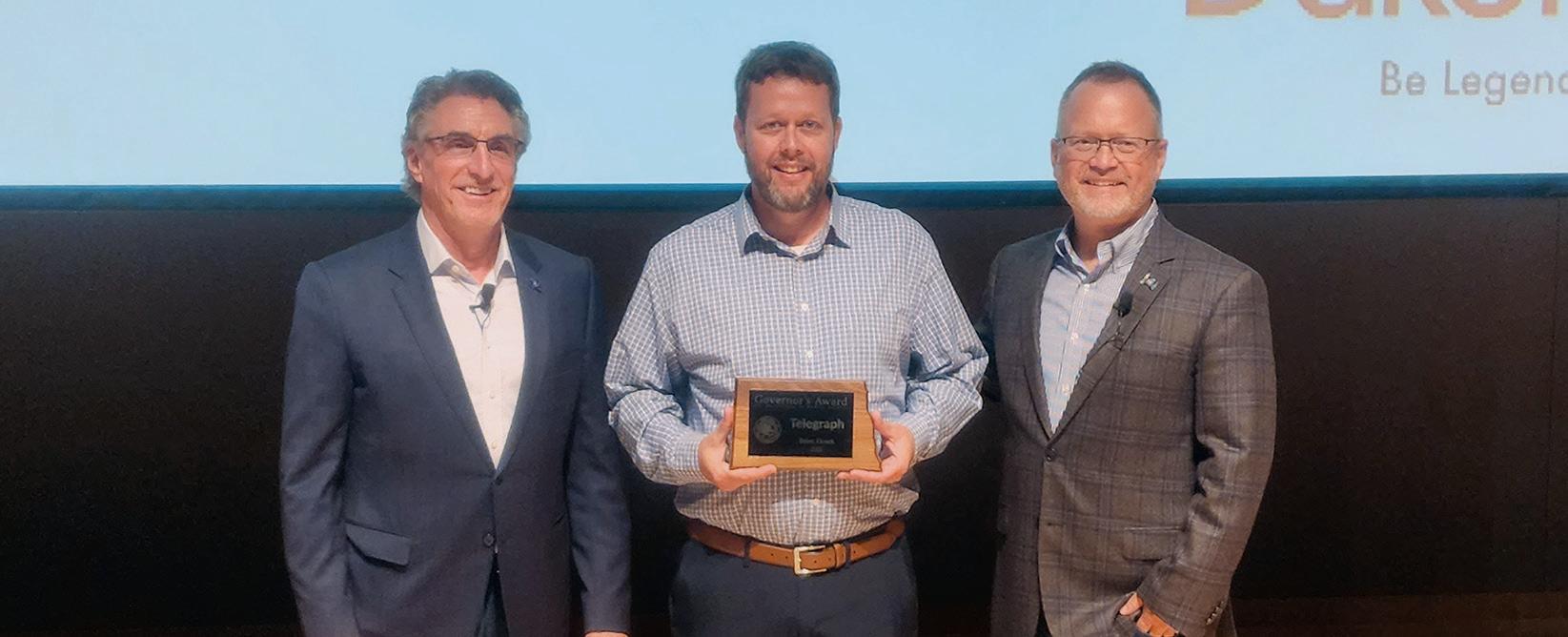
“Brian’s creativity, work ethic and commitment are well known and respected within the Department, but it is always extra rewarding to see our staff receive recognition from others who also see their talents, especially the governor,” said Jeb Williams, Game and Fish Department director. “Governor Burgum’s commitment to recognizing state team members has been phenomenal and for Brian to receive this year’s Telegraph Award is really meaningful and I couldn’t be happier for him.”
Elstad Retires
Kjos Joins Fisheries Development Staff

Zach Kjos has been named a fisheries development specialist for the Game and Fish Department in Bismarck. Prior to his new position, Kjos worked as a Department wildlife technician for four years in Williston.


Eustice Named to Wildlife Staff
Zach Eustice has been named a wildlife technician for the Game and Fish Department in Williston. Eustice worked as a seasonal wildlife technician at the Lonetree Wildlife Management Area district prior to his new position.
Scott Elstad retired after 27 years with the North Dakota Game and Fish Department. At the time of his retirement, Elstad was the Department’s aquatic habitat supervisor and directed the Save Our Lakes program, which contributed greatly over the years in improving fishing in North Dakota, including creating new fishing opportunities in community ponds around the state.
Gov. Doug Burgum (left), Brian Hosek (center) and Lt. Gov. Brent Sanford.
ND OUTDOORS ■ OCTOBER 2022 ■ 23
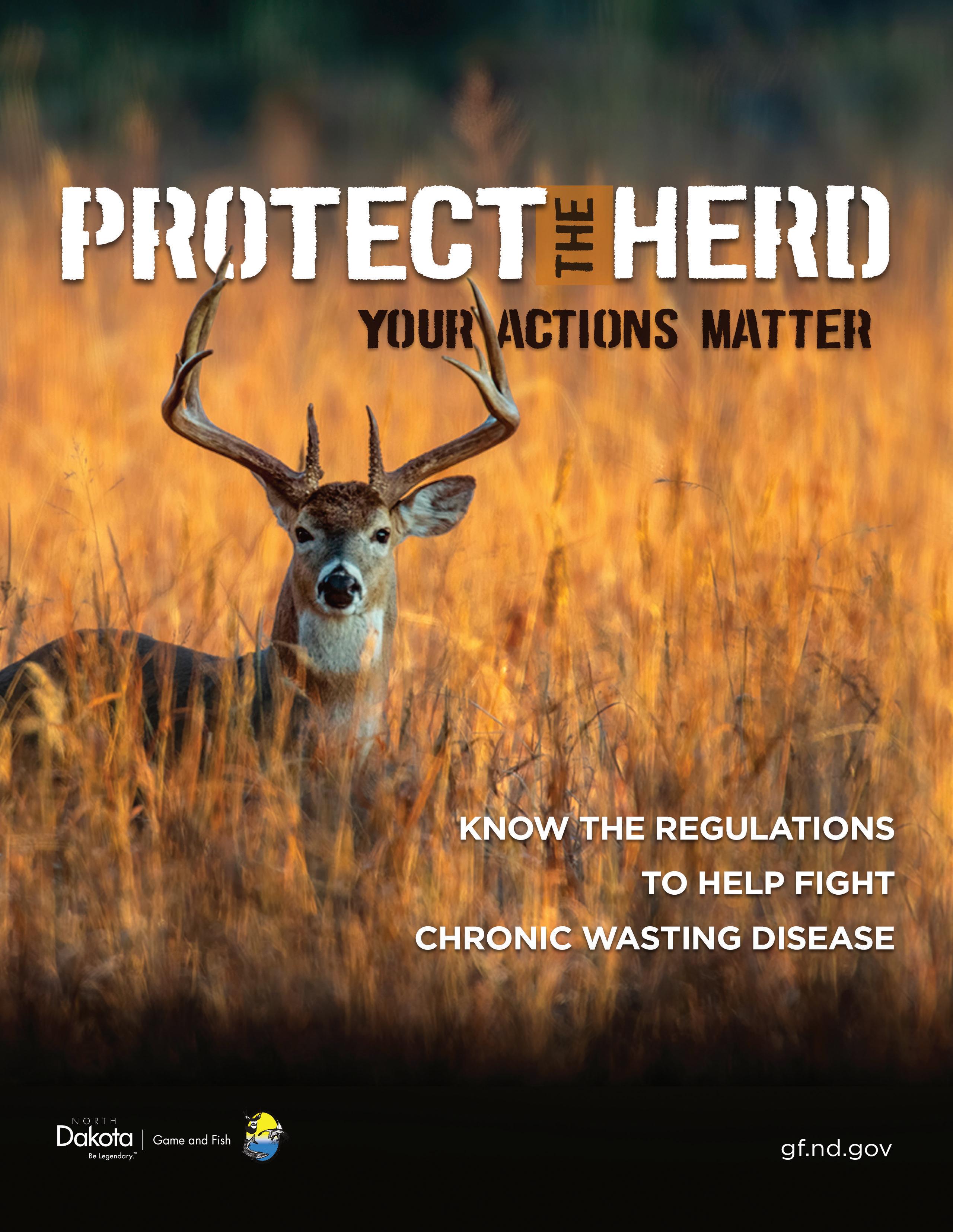
24 ■ ND OUTDOORS ■ OCTOBER 2022
BACK CAST
We’ve long endorsed at Game and Fish the importance of building quality hunterlandowner relations, including what bonehead moves not to make to weaken them.

It’s straightforward stuff. Stay off private land you don’t have permission to access. Don’t litter. Leave gates the way you found them, and so on.
Simple enough.
Even so, I get unnecessarily uneasy whenever I’m approached by a landowner, thinking that I overlooked something, messed up and didn’t know it.
We’re milling around my pickup on public land in western North Dakota on the sharptail opener, grabbing shotgun shells from boxes, taking slugs of water, but mostly deciding how to walk this large chunk of public land that seems to stretch forever but really doesn’t as private property breaks things up here and there, according to the GPS navigator that’s dominated my phone’s screen since sunrise.
I heard the unmistakable, low rumble of a four-wheeler in the distance some time ago, didn’t pay much attention to it, but now I’m sure its rider is heading in our direction on the other side of the fence that is certainly private.

Maybe he’s checking fence, looking for a cow that’s gotten loose, I wonder out loud. I guess we’re about to find out, I say to my sons.
We meet at the fence, offer “good mornings,” and immedi ately start talking about the weather, the universal icebreaker. I tell him that earlier this morning we saw frost on an alfalfa field down in one of the valleys west of here and he says that he had to pull out a quilt last night to fight off the chill.
Yep, the weather has changed, we agree.
We talk about elk and elk hunters, and he says he’s seen more of the latter than the former of late. We move on to grouse, the reason my sons and I are parked on this hilltop, and he says he saw some while haying, making it sound like it was days ago, not yesterday.
I’m not good at guessing age, but for whatever reason I think maybe we’re close to the same age even though my beard is certainly the grayest. It’s not important, really, just a curiosity as we visit over the barbed wire divider.
By Ron Wilson
We don’t exchange names, but I do learn that he lives near here in the general direction he motions to over his shoulder with his thumb without turning.
While I’ll likely never know who this gentleman is, it’s at least apparent why he’s gone out of his way, veered off the main gravel road to slowly negotiate the two-track on his side of the fence to this hilltop. He simply wanted to visit. Shoot the breeze during a pause in his morning. Talk about the weather.
We shake hands over the fence, say our goodbyes, and he wishes our small party good luck, adding: “If you see any kit ties, don’t tell me about it.”
I chuckle at that, because he does, guessing it passes for mountain lion humor in these parts.
I’m still thinking about our conversation as we hike this up and down public land, heading from one buffaloberry patch to the next, looking for just three more grouse to fill our bags. And it dawns on me that while much of the onus in hunterlandowner relations reasonably falls on the hunter, the gate of this relationship certainly swings both ways.
RON WILSON is editor of North Dakota OUTDOORS.
CAYLA BENDEL
ND OUTDOORS ■ OCTOBER 2022 ■ 25
N. Bismarck
ND 58501
To renew your subscription or change your address, call 701-328-6300 or go to gf.nd.gov/buy-apply.
As is the case most years, hunters will likely bump into young roosters early in the season that haven’t fully feathered out. But, as the season progresses, these young birds will eventually don the wide array of colors that help make them North Dakota’s top upland game bird.
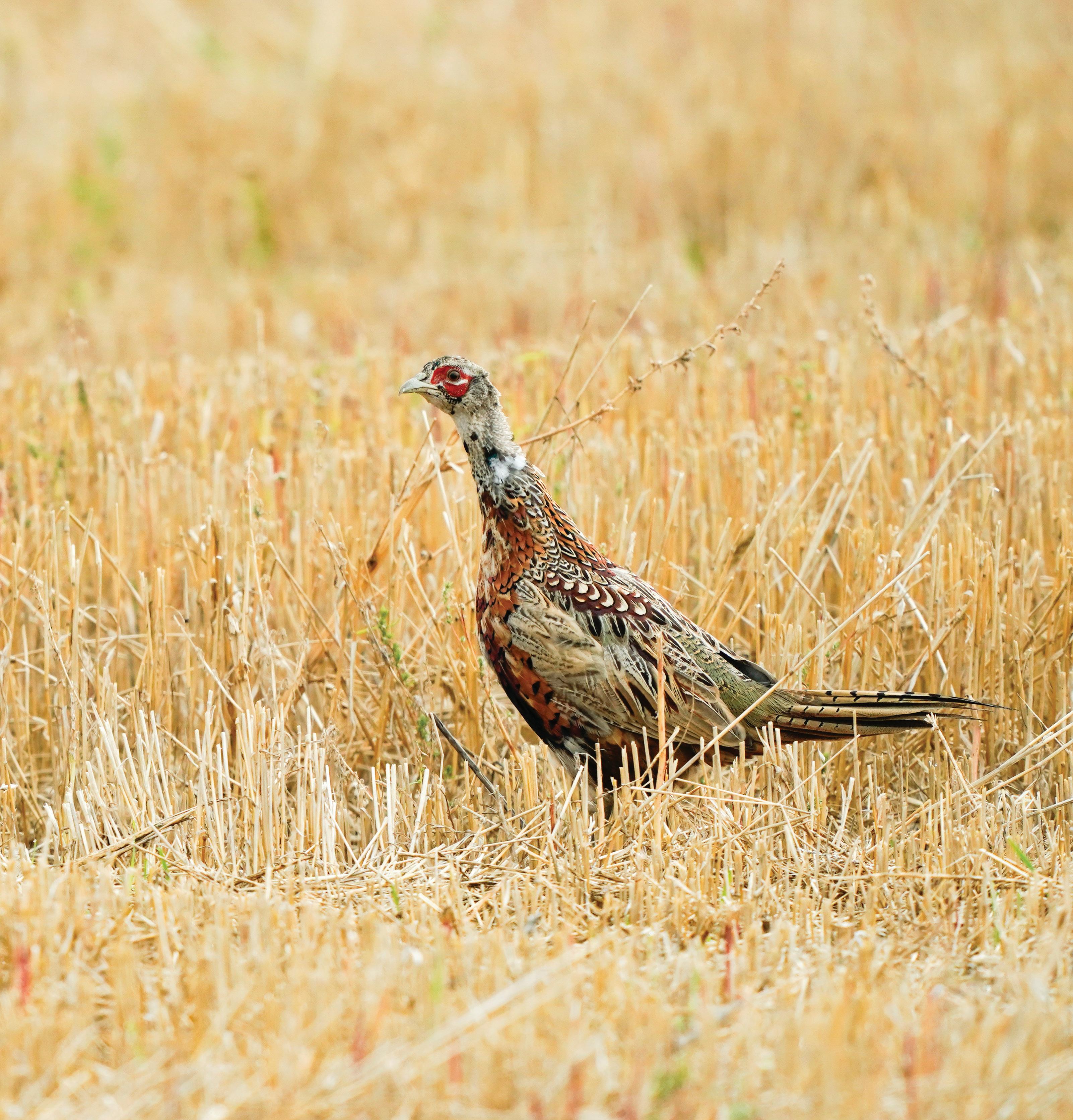
North Dakota Outdoors Magazine North Dakota Game and Fish Department 100
Expressway Bismarck,
connect with us gf.nd.gov/connect
ASHLEY
PETERSON







 SANDRA JOHNSON
SANDRA JOHNSON



















































